mudd

SUMMER 2023 THE MAGAZINE OF HARVEY MUDD COLLEGE
Meet President Harriet Nembhard
Class of 2023 By the Numbers
201 GRADUATING SENIORS
31.6% FROM HISTORICALLY UNDERREPRESENTED GROUPS
11.6% FIRST-GENERATION
60.3% JOINING WORKFORCE
23.7% ATTENDING GRADUATE SCHOOL

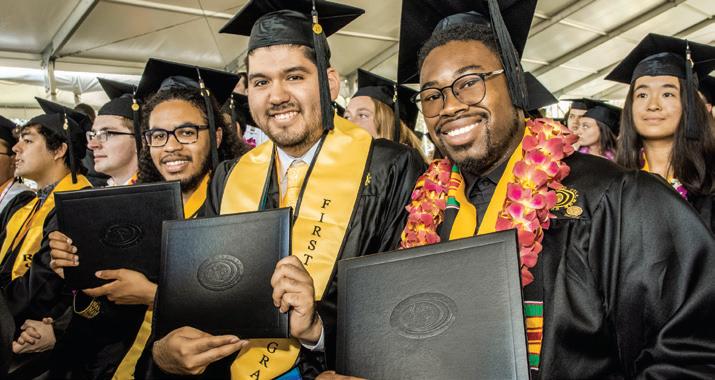

105 AWARDED HIGH DISTINCTION

63 AWARDED DISTINCTION
14 COMPLETED EMPHASIS IN ENVIRONMENTAL ANALYSIS
Tyson-Jay Saena and family
Bradley Gonmiah, Cristian Gonzalez and Raffa Gonzalez Anirudh Satish and Arya Goutam
Download free images from HMC Flickr, bit.ly/gradimages2023
Video of ceremony: bit.ly/3Y8gybP
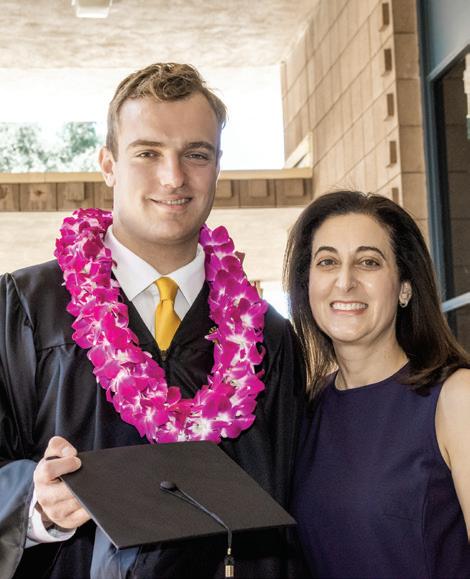


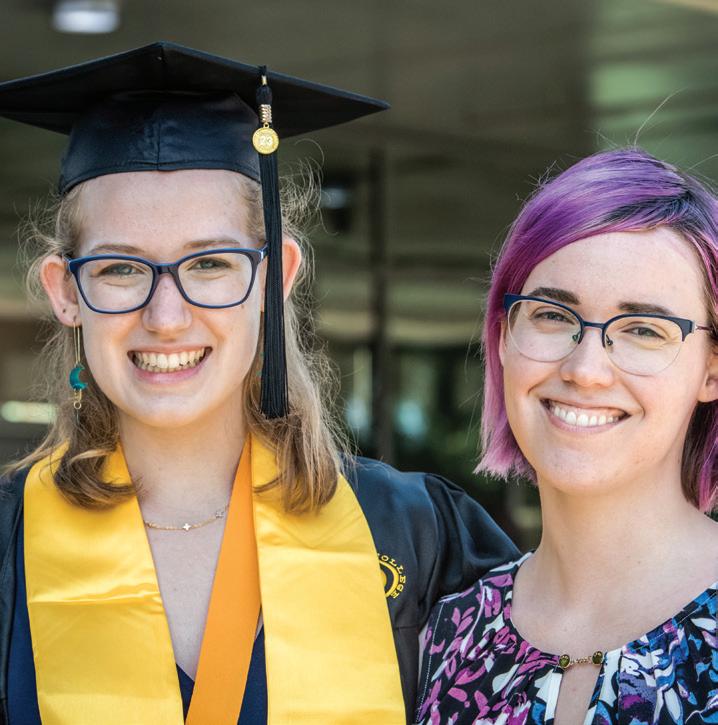 Austin Froelich and family member
Katie Johnson and Professor Xanda Schofield ’13
Sonia Bliss
Back: Mavis Stone, Ella Blake; Middle: Jeremy Bakken, Emma Lickey, Eric Corona, Helen Chaffee, Jackson Castro; Front: Inci Anali, Ruby Foxall, Sydney Cornell, Bela Quintas
Austin Froelich and family member
Katie Johnson and Professor Xanda Schofield ’13
Sonia Bliss
Back: Mavis Stone, Ella Blake; Middle: Jeremy Bakken, Emma Lickey, Eric Corona, Helen Chaffee, Jackson Castro; Front: Inci Anali, Ruby Foxall, Sydney Cornell, Bela Quintas
CONTENTS
Summer 2023 | Volume 23, No. 3
Mudd Magazine is produced three times per year by the Office of Communications and Marketing.
Director of Communications, Senior Editor Stephanie L. Graham, APR

Art Director Robert Vidaure
Senior Graphic Designer Joshua Buller
Associate Director Sarah Barnes
Eight Great Things to Know About President
Nembhard
A family legacy, groundbreaking research, lessons from Covid and ways she’s partnering for future possibilities.
The Physics Major Goes To China
Roger Cliff ’83 brings his insight into Chinese society, politics and the military to the U.S. Indo-Pacific Command.
Writers Judy Augsburger, Dominic Indolino, Arturo Molina
Contributing Writers
Leslie Mertz, Jen A. Miller
Contributing Photographers
Shannon Cottrel, Dana Edmunds, Jeanine Hill, Dominic Indolino, Anita Nowacka, Jordan Stone ’24
Proofreader Kelly Lauer
Vice President for Advancement
Hieu T. Nguyen
Chief Communications Officer Timothy L. Hussey, APR

Mudd Magazine
We

Award-winning, early career physicist pursues pioneering research.

Follow HMC Instagram, Threads – @harvey_mudd Facebook – @harveymuddcollege
LinkedIn – harvey-mudd-college X/Twitter – @harveymudd
(SSN 0276-0797) is published by Harvey Mudd College, Office of Communications and Marketing, 301 Platt Boulevard Claremont, CA 91711.

Nonprofit Organization Postage Paid at Claremont, CA 91711
Postmaster: Send address changes to Harvey Mudd College, Advancement Services, 301 Platt Boulevard, Claremont, CA 91711.
Read Mudd Magazine Website: magazine.hmc.edu
Go paperless: If you wish to stop receiving the printed magazine, write to us at communications@hmc.edu. We’ll send you an email when new editions are posted.
Copyright © 2023—Harvey Mudd College. All rights reserved. Opinions expressed in the Mudd Magazine are those of the individual authors and subjects and do not necessarily reflect the views of the College administration, faculty or students. No portion of this magazine may be reproduced without the express written consent of the editor.
Mudd Magazine staff welcomes your input: communications@hmc.edu or Mudd Magazine, Harvey Mudd College, 301 Platt Boulevard, Claremont, CA 91711 magazine.hmc.edu
HA R VEY MUDD COLLEGE MAGAZINE 2
26
20
Harriet
34 Quantum Possibilities
28 The Ultimudd Gift Guide
offer another collection of products created
options
holidays. Departments 4 College News 16 Research 18 Clinic 30 Mudderings 33 Class Notes
by entrepreneurial alumni that are great
for the upcoming
Connecting with Community



With support from the presidential transition task force, there are an extensive set of meetings and a listening tour during the first 100 days of Harriet Nembhard’s presidency (through Oct. 10). At events, panels, regional receptions and other activities, President Nembhard is hearing thoughts and suggestions on ways to continue the College’s important mission. Attend an event and/or complete the survey to help shape the future direction of the College.
More information at hmc.edu/community-connections Scan
SUMMER 2023 3
the QR code to complete the survey.
Summer Welcome Reception at HMC for incoming students and their families, Aug. 6
Aug. 6 reception
Faculty/Staff Meet and Greet, July 13
New Joint Major
Students whose interests lie at the intersection of physics and computer science now have the option of declaring a joint major in those fields. Courses in the College’s new CS/physics major will explore recent discoveries in complex physical systems enabled by highperformance computing and/or machine learning as well as quantum computing and quantum information science.

Trustee Update
New trustees
Amyn Rajan P27, CEO strategy coach, Rajan Holdings
Pat Copeland P27, chief engineering officer, Zendesk
Reelected for three-year terms
Howard Deshong ’89, P22, Matthew Ferri, Mar Hershenson P24, Laura Larson P20, Allan Leinwand P27, Tyler Mingst P22, Michael Schubmehl ’02
Advisory trustees rejoining the board Murray Goldberg, Bruce Worster ’64

Alumni representative
Gregory Rae ’00, immediate past president, Alumni Association Board of Governors
Recent graduate trustee
Kacyn Fujii ’13
HA R VEY MUDD COLLEGE MAGAZINE 4 COLLEGE NEWS
The American Institute of Architects recently awarded the 2023 Facility Education Design Award of Excellence to the Scott A. McGregor Computer Science Center. The prestigious honor recognizes the principles of good design in the 21st century.
The Henry T. Mudd Prize recognizes extraordinary service Ruvalcaba Aims for the Best


the 2023 henry t. mudd prize awardee is a longtime, self-described foodie. Miguel Ruvalcaba has been cooking or working in the food industry since age 14. Growing up in a family of 12, he says he’s used to cooking for and solving problems with large groups of people. He took a cooking class in high school and loved it. Since then, he’s worked at nearly every food-related job, from busboy to catering manager, so he has a thorough understanding of the business.
“I started as a busboy and then was a host and dishwasher,” Ruvalcaba says, referring to his jobs at Reuben’s Steakhouse in San Bernardino. “I always wanted to cook, so I would stay behind and learn. One day when the cook wasn’t there, I jumped into the kitchen and, at age 15, I was cooking at the restaurant. That’s where I met my wife.”
Ruvalcaba began working at Harvey Mudd in 2010. As senior director for dining services, he leads one of the largest departments on campus and is known for his collegial and respectful manner, which exemplifies every aspect of work with his team members, whom he’s quick to acknowledge for their efforts. He directs all food-related services for the College, including Hoch-Shanahan Dining Hall, the Café, catering and Jay’s Place.
In addition to providing training for all employees in food and physical safety, customer service and recipe development, Ruvalcaba works closely with campus administrators to provide high-quality service and delicious, healthy food. During the academic year, he meets weekly with the Student Food Committee to discuss implementing new menu ideas and arranges student events, like Copper Chef, an idea he presented during his HMC job interview. The event helps students build community around a shared meal and the fun of a student competition.
“Harvey Mudd College is a wonderful institution. It’s academically rigorous and, given the challenges our students face, I want food to be the last thing they have to worry about. I advocate and partner with my supervisor to make sure we have the resources to provide the best meal program to serve our hardworking students,” says Ruvalcaba.
Mentor-Teacher
The prize: The Binder Prize honors HMC support staff “who combine a record of exceptional service with a truly helpful and friendly attitude toward students, faculty and fellow staff members.” The $1,000 prize was established in 1996 by engineering Professor Emeritus Sam Tanenbaum and his wife, Carol, in honor of Carol’s mother.
“I love what I do. I enjoy providing delicious meals and creatively responding to challenges, such as meeting dietary restrictions or reducing wait times during rush hours. I enjoy the planning and execution of events like Ramadan and Copper Chef,” Ruvalcaba says. “My team and I strive to meet or exceed our community’s expectations regarding food.
“I want to continue to maintain the reputation among the HMC and Claremont community of being one of the best dining halls at The Claremont Colleges.”
Ruvalcaba’s Fast (Food) Facts
Favorite meal: steak, shrimp scampi
Something he can eat over and over: Capirotada, a dessert, similar to bread pudding
Favorite restaurant: Rodizio in Salt Lake City, Utah
How he’s directing half of the $6,000 Mudd Prize: He says he’ll decide after meeting with the Student Food Committee.
The recipient: Laboratory and Stockroom Manager Daniel Guerra, an HMC employee since 2012, manages all chemical and supplies ordering for the teaching and faculty research labs in the Department of Chemistry. Nominators complimented Guerra on his patience, organization, kind-heartedness, positivity, helpfulness, creativity and expertise. One commented, “Daniel also supervises students who work in the stockroom with him. He is not only their supervisor, but also a mentor and a teacher. … He explains how he organizes the chemicals, why he does things the way he does and how they can take these lessons into their own lives. You can tell the students who work with Daniel in the stockroom are learning from him, not just working for him.”
Guerra says: “This is truly my dream job. The faculty, staff and students in the chemistry department are all exceptional human beings and a pleasure to work with.”
SUMMER 2023 5 COLLEGE NEWS
Student Affairs Veteran Hired as Interim VP


cynthia (cindy) martinez is serving as the interim vice president for student affairs and is partnering with the President’s Cabinet and Division of Student Affairs staff to lead day-to-day student affairs operations. Working with cabinet members, she will begin addressing issues identified in the DSA External Review report, which was shared with the HMC community on June 14.
Martinez brings more than 20 years of academic and student affairs leadership experience to the position. At Keck Graduate Institute, she served most recently as associate dean of the Community Medicine Program/ professor of practice. She was the dean of students for five years, providing strategic leadership for Academic Support Services, Career Services, Student Accessibility Services, Orientation Services, Student Activities,
Student Conduct, Student Housing, Student Health Insurance, Student Government, Student Occupational Therapy Services, Student Wellness and Title IX. Given her roles at KGI, Martinez has extensive knowledge and experience working collaboratively with The Claremont Colleges Services and other Claremont colleges. She previously worked at USC as the interim assistant dean for student affairs in the Annenberg School for Communication and Journalism and as the executive director for graduate and undergraduate advisement and academic services. Martinez holds a bachelor’s degree in biology from Cal Poly Pomona; a master’s of education in postsecondary administration and student affairs from USC; and a PhD in organizational leadership from the University of San Diego.
In Memoriam
Deren Finks
Dean of Admission Emeritus Deren Finks, who admitted hundreds of students during his 17-year tenure at Harvey Mudd College, died April 18, 2023.
Finks joined the College’s new admission office in 1988 under then admission director Duncan Murdoch. During his time at the College, Finks worked with the admission team to help shape the Harvey Mudd community, eventually taking the lead as vice president and dean of admission and financial aid. On the citation of the College’s Henry T. Mudd Prize, awarded in 2002, Finks was lauded for having been “directly involved with every Mudd student for the last 14 years …. [for having] done more than any other single individual to maintain and improve the already high standards of admission to the College.” Finks was also heralded for helping improve the gender, racial and ethnic diversity of the Mudd student body.
Read Finks full biography at hmc.edu/in-memoriam/deren-finks
HA R VEY MUDD COLLEGE MAGAZINE 6 COLLEGE NEWS
Harvey Mudd was named a 2023–2024 Voter Friendly Campus by the Campus Vote Project. The designation highlights institutions for their continued efforts to break down barriers and empower students with the information and tools they need to participate in the political process.
Cindy Martinez
Collaborations in Student Design Experiences
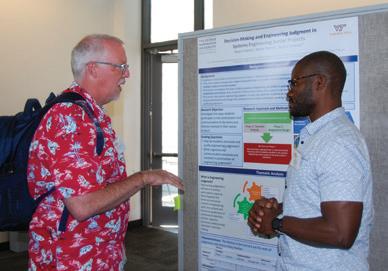

Committed to supporting the broader engineering design education community, the Department of Engineering hosted the 23rd Clive L. Dym Mudd Design Workshop in June, gathering 53 engineering educators, designers and researchers from across the globe. The three-day workshop’s central theme, “Collaborations in Student Design Experiences,” allowed attendees to delve deeper into the ways industry and community partnerships can be leveraged in engineering design education. Session topics, like Collaborative Design Processes, Community-Engaged Design, Problem-Solving in Engineering Design, and Diversity and Equity in Engineering Design, reflected key issues in the field. Presenters came from institutions worldwide—from the University of Michigan to Singapore University of Technology and Design— underscoring the international and interdisciplinary nature of the event.
After welcoming remarks by Nancy Lape, engineering department chair, two keynote addresses punctuated the workshop. Dorota Shortell, CEO of Simplexity Product Development, discussed industry best practices in the product development process. William Oakes, 150th Anniversary Professor and director of the EPICS Program at Purdue University, provided insights into designing partnerships for value and respect. Interactive poster sessions facilitated high levels of engagement as authors presented their research on diverse topics, such as the effectiveness of diversity experiences in design education and the communication skills of undergraduate engineering students in project-based learning. The concluding session, led by Ade Mabogunje of Stanford University, encapsulated the insights and learnings garnered over the three days, cementing the workshop’s role in fostering a rich discourse on engineering education.
“The Clive L. Dym Mudd Design Workshop XXIII stands as a testament to the dedication of educators, researchers and professionals worldwide to collaborative learning, inclusivity and equipping students to tackle the future challenges and opportunities of engineering design,” says conference organizer Gordon Krauss, Fletcher Jones Professor of Engineering Design.
SUMMER 2023 7 COLLEGE NEWS
Participants of the 23rd Clive L. Dym Mudd Design Workshop
SYDNEY TORREY
The De Pietro Program Legacy Spring Retirements
Written by Arturo Molina and Dominic Indolino
Geoff Kuenning joined the computer science faculty in 1998 after a pivotal gathering.
“After I was offered the Mudd job,” Kuenning says, “my wife and I came back to visit the campus with our brand-new adopted daughter. The entire CS department (then only six people) and their families met at Ran Libeskind-Hadas’s house for an evening of takeout Persian food. The intimacy and warmth of that get-together was a big factor in my decision to join Mudd.”
During his 25 years, Kuenning taught courses on data structures and program development, operating systems, file systems and computer systems performance analysis. He received eight NSF grants and has published numerous articles in prestigious journals and conference publications. Kuenning authored many aspects of the CS curriculum and served as a study abroad advisor and off-campus liaison. He spent almost a decade as the Engineering Clinic director.
Known for his candid conversations, Kuenning is also revered for his mentorship, particularly with junior faculty.

Kuenning’s advocacy for students is also well-known. He often encouraged those who might be reluctant into the CS major. Kuenning says, “It’s really not about the moments; it’s about continuous experiences. My favorite class is CS 5, where I get to bring the breadth and beauty of CS to students who are just starting college. It is truly a joy to see the fascination and eagerness with which they respond.”
Kuenning shared that he plans to ride his bike a lot and hopes to complete a San Francisco-to-Los Angeles ride along Highway1 during his retirement. He adds, “I will also return to chasing my daughter around the world (she keeps moving), perhaps work on a textbook, and my wife wants me to practice the piano again.”
Ziyad “Zee” Durón ’81, the Jude and Eileen Laspa Professor of Engineering, is an expert in the full-scale field testing of large structures, including seismic investigations and earthquake engineering. He is a leader in the development of field-test procedures aimed at identifying response characteristics from low-level vibrations that occur naturally in all structures and has developed highly sensitive instrumentation for monitoring hydrodynamic pressure wave propagation for use in seismic investigations of concrete dams. Since entering the field in 1985, Durón has headed more than 20 field tests on a variety of structures, including concrete dams, buildings, bridges and launch vehicles.
After 25 years at Mudd, Durón’s impact has been as big as the dams he works on. He says, “I came to HMC in large part because many of the founding faculty were here, which gave me a lot of access to their thinking about the program, how they built it and how it actually worked. I stayed at HMC because of the students, and it is the students that I will miss the most.”
Durón introduced field experience into the experimental engineering course to give students a real-life example of what engineering in the professional field feels like. He developed several courses for the engineering curriculum, including a design, manufacturing and management program that was dedicated to fostering leadership and professional skills. A colleague noted that Durón “really works to ensure that the department was always ahead of the curve and responding to whatever was happening in the world. He really pushed to expand what we could do in our program and what we offer for our students.”
Durón served as department chair for seven years and brought in significant financial resources for the engineering department.
During retirement, Durón will remain active as a consultant in dam safety and will work with young professional engineers as they build their careers. He says, “I want to thank the College for affording me all the support and resources for what turned out to be a great career.”
Zee Durón worked with the College and the De Pietro family to launch the Frank and Frances De Pietro Fellowship Program in Civil Engineering.
“The late Franklin De Pietro had a vision that led him and his wife to prominence in Los Angeles during an era when hardworking immigrants in the United States often found opportunities that they had perhaps only dreamed about,” Durón said. “That gift, generously and graciously entrusted to the College, has provided a way for their family values to live on.”
The program was created in 1998 by brothers Robert ’69 and Dennis De Pietro in honor of their parents, Frank and Frances, to support undergraduate research in civil engineering. Robert, an engineering alum, said, “Zee already had a vision and suggested because of our family’s link in supporting the College that we might consider something that would have a more lasting value to the student experience.”
Since the launch of the fellowship program, Durón has worked with over 60 fellows on civil engineering projects across California. In May during a Department of Engineering celebration for Durón, 11 former fellows shared their thoughts on the impact of the De Pietro Program and their experiences working with Durón.
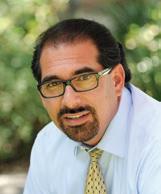
Zach Rubin ’08 recalled his first experiences in field engineering. “I was taught to make engineering decisions with the clarity to see the limitations of the work that we do and the integrity to say those limitations out loud.”
Gene Lee ’04 said that through the program and Durón’s guidance, he learned to solve complex, open-ended problems which helped him grow as a team leader who now effectively communicates with his team at the Jet Propulsion Laboratory.
Durón said that hearing about what his students have gone on to do is very humbling. “The goal for me was to create a program that could change the way you [students] think and learn and to create within each of you the ability to be better than I could ever be.”
HA R VEY MUDD COLLEGE MAGAZINE 8 COLLEGE NEWS
Meet the New Faculty
Computer Science
1. Arthi Padmanabhan joined the department as a visitor in fall 2022. With degrees in computer science from UCLA’s Henry Samueli School of Engineering and Applied Science (PhD) and Pomona College (B.S.), Padmanabhan is broadly interested in systems and networking. Her research focus is on building systems that enable scalable machine learning on real-time video data.
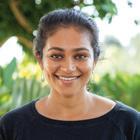
2. Calden Wloka became a visiting assistant professor in 2021. He heads the Lab for Cognition and Attention in Time and Space (Lab for CATS) in which he studies visual perception from the perspective of both artificial and biological systems. Wloka earned an M.S. and PhD at York University as a member of the Tsotsos Lab for Active and Attentive Vision.
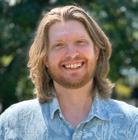
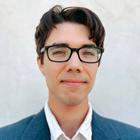
Chemistry
3. Bilin Zhuang double majored in physics and chemistry at Wellesley College and earned a PhD in chemistry from Caltech. Her graduate research involved developing statistical field theories for liquid mixtures under both equilibrium and non-equilibrium conditions. She has served as a staff scientist at the Institute of High-Performance Computing and as an assistant professor of chemistry at Yale-NUS College in Singapore. Zhuang studies the chemistry and physics of how molecules organize themselves in complex liquids with pen-and-paper theories and computer simulations.
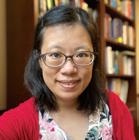
Engineering
4. The work of David Nembhard sits at the intersection of human factors, operations management and production. Primarily focused on human learning, Nembhard has made significant contributions to the fields of human factors and management sciences by designing individualized learning systems that account for individual differences in skill levels, learning, forgetting, temporal motivation, cognition, personality and modes of communication. Previously, he served as the director of industrial and manufacturing engineering graduate programs at Penn State University and has been a faculty member at the universities of Auburn, Wisconsin, Oregon State and Iowa.
5. Sophia Plata researches alternative water treatment and the water-energy nexus. She aims to solve critical contaminant and energy challenges across potable and industrial applications to increase water reuse. Currently a visiting assistant professor at Swarthmore College, Plata completed her B.S. in civil engineering at Widener University and earned her PhD in environmental engineering from USC. Plata is a member of the American Society for Engineering Education and has held leadership positions in the Society of Hispanic Professional Engineers. She begins work in January 2024.
6. Ethan Ritz ’12 (engineering) came to HMC from University of Minnesota, where he was a postdoc in computational materials science. Ritz earned his PhD in mechanical engineering at Cornell University, using computers to predict and understand the thermal properties of materials based on aspects of their crystal structures and atomic-scale chemical bonding environments. Ritz will continue exploring the mechanical, electronic and thermal properties of materials and seek to discover new materials that will help drive the new energy infrastructure needed to combat climate change.
Humanities, Social Sciences, and the Arts
7. Dede Long is an environmental economist who applies microeconomic theory and econometrics to better understand the economic drivers and environmental consequences of environmental policies. Long’s research is focused on the health effects of air pollution, consumer preferences for eco-labeling and the economic benefits of

coastal ecosystem restoration. She earned her PhD in applied economics with a specialization in environmental economics from Oregon State University and recently served as an assistant professor at California State University, Long Beach.
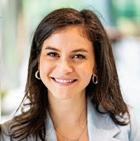


Hixon Center for Climate and the Environment
8. Sarah Kavassalis arrived at Harvey Mudd in 2020 to participate in the College’s Postdoctoral Program in Interdisciplinary Computation. Her research centers on creating novel computational tools to answer important questions about air quality and climate. Kavassalis is especially interested in how non-linearities in the earth’s system manifest themselves and how best to capture these interesting complexities with models. She has a B.S. in physics and a PhD in chemistry from the University of Toronto.
9. Lynn Kirabo investigates the future of equity in smart public transit systems by centering the lived experiences of persons with disabilities in urban cities. She designs frameworks that policymakers can leverage to nudge their transportation ecosystems toward equity. Kirabo holds a bachelor’s degree in information technology from Makerere University, two master’s degrees: information technology from Carnegie Mellon University (CMU) Africa and human-computer interaction from the HumanComputer Interaction Institute (HCII) at CMU. Her PhD in human-computer interaction is also from HCII. She’s also an experienced front-end developer and software engineer.

SUMMER 2023 9 COLLEGE NEWS
6 7 8 9 1 2 3 4 5
Research, Awards, Activities Faculty Updates
Biology
In a recent paper published in Microbiology Spectrum, Danae Schulz and co-authors Ethan C. Ashby, Jennifer L. Havens ’18, Lindsey M. Rollosson ’20 and Johanna Hardin, report that gene expression is also affected by chemical bromodomain inhibition in insect-stage parasites but that the genes affected differ depending on life cycle stage. Their work may lend insight into how gene-regulatory mechanisms evolved and could be leveraged to generate new therapeutic strategies.

Dan Stoebel was a speaker for the spring HMC BioMakerspace talk series. A student-run biology laboratory hosted by HMC, the BioMakerspace provides members of The Claremont Colleges with access to space, materials and funding for biology projects that push the boundaries of genetic engineering. Stoebel discussed experiments he and his students performed to better understand how promoters respond to changing levels of RpoS, a central regulator of general stress response.
Chemistry
Lelia Hawkins and Katherine Van Heuvelen were promoted to the rank of full professor. Hired in 2011, Hawkins is professor of chemistry and Hixon Professor of Climate Studies. She is director of the Hixon Center for Climate and the Environment, which aims to be a leading center for undergraduate climate curriculum, research and campus practice. Hawkins studies how atmospheric particles in urban settings are transformed as they age and how they impact the temperature of the earth. An NSF CAREER award recipient, Hawkins is one of the researchers measuring airborne particulate matter as part of a $12 million, multi-state project.
Van Heuvelen joined the chemistry faculty in 2012 and has served as associate dean for faculty development and diversity and, now, associate dean of faculty. She and her research students study nickel and cobalt complexes using multiple spectroscopic and computational techniques. In 2018, she was a fellow in the Claremont Faculty Leadership Program, and
she received the College’s Outstanding Faculty Member award in 2022.
Computer Science
During his talk, “N+1 Lessons I’ve Learned Through a Decade in Artificial Learning,” George Montañez shared what he’s discovered about artificial learning methods since his time as a graduate student in the early 2010s. He has seen both the need for biases in learning systems and the folly of uncritically incorporating biases without careful examination. Progress in the field of artificial learning has been accelerated and uneven, with stalls and bursts, but continues to move forward with reminders to embed our best values in our algorithms.
Xanda Schofield ’13 earned a second, two-year appointment as assistant professor. Schofield specializes in designing easy-to-use tools for large-scale corpus text mining and is interested in integrating privacy into machinelearning-aided data mining in natural language processing. She is co-principal investigator on an NSF grant to support projects with the theme “Exploring the Limits of Intelligent Systems.” Funding for the research experience for undergraduates will support approximately 10 students per summer for the next three years.
Erin Talvitie, associate professor of computer science, associate department chair and a faculty member since 2019, has earned tenure. Talvitie, who helped establish Franklin & Marshall College’s computer science major before coming to Harvey Mudd, specializes in applying machine learning to problems of artificial intelligence, working toward artificial autonomous agents that can learn to act flexibly and competently in unknown environments.
Ben Wiedermann received a promotion to the rank of full professor. He researches the design and implementation of programming languages and tools and has helps programmers build
efficient and extensible distributed applications. He also designed and teaches a lab-based course on puzzles, where students investigate how to use what they’ve learned in other courses to make puzzles and games. He and fellow CS professor Zach Dodds received an NSF grant for the continuation of an REU site in computer science to support undergraduate research of computer systems.
Engineering
In April, for the College’s Mudd Talks series, Josh Brake discussed “The Power of the Prototyping Mindset: How Embodied Questions Can Help You Build a Meaningful Life and Career.” Brake shared ways that a prototyping mindset has helped him make progress on the things that matter to him and offered ideas that others might adopt. His second, two-year appointment as assistant professor was renewed in May.
Design thinking and innovation are specialty areas for Fred Leichter, clinical professor of engineering and director of The Claremont Colleges’ Rick and Susan Sontag Center for Collaborative Creativity (the Hive). He and Dabney Hailey, founder and director of the Hailey Group, combined the teaching of human-centered design (HCD) and Visual Thinking Strategies (VTS), in the class Advanced Topics in HumanCentered Design, co-taught during fall 2021. They coached a group of five students through a design challenge with Dana-Farber Cancer Institute exploring how to help new cancer patients and their families navigate the information overload that often comes along with a cancer diagnosis. Read the article about what they found at the intersection of HCD and VTS in Medium at bit.ly/hcd-vts.
Patrick Little, professor emeritus of engineering and visiting scholar, co-chaired the National Science Foundation-funded conference workshop “Prototyping, Developing and

HA R VEY MUDD COLLEGE MAGAZINE 10 COLLEGE NEWS
Exploring Collaborative Relationships Among Germination Researchers” with Tom Maiorana, assistant professor, Department of Design, UC Davis. The project connects academic researchers in the STEM fields and helps them establish connections across the NSF Germination research community. Held during spring at HMC, the workshop fostered creative approaches and relationship building.
Steven Santana has received two prestigious awards supporting his research. The NSF is supporting his interdisciplinary project that will enhance the understanding of cell communication. The project, “BRC-BIO: Interrogating Extracellular Vesicle Biogenesis
Through Substrate-Associated Signals,” represents an opportunity for Santana, HMC students and high school students from HMC’s Upward Bound program and from the Pomona Unified School District to make a meaningful contribution to the scientific and engineering communities. The Alfred P. Sloan Foundation awarded Santana $10,000 for his project "Deciphering the Material Factors that Inspire Extracellular Vesicle Production.” This spring, Santana earned a second, two-year appointment as assistant professor.
Humanities, Social Sciences, and the Arts
In an interview with VoyageLA, which “find[s] the amazing souls that breathe life into our city,” Bill Alves details his musical journey, exploration of diverse musical traditions and commitment to creating music that brings beauty to his communities. Alves also describes his recent venture into virtual reality—Asterism—and how he incorporates music and visual art into an immersive experience.
Alfred Flores, Asian American studies professor, is the recipient of a highly competitive National Endowment for the Humanities Summer Stipend. He will use the $6,000 award to fund preliminary archival research and to conduct oral history interviews for his second book, Transoceanic Micronesians: CHamoru and Marshallese Diaspora in Southern California. By forging and maintaining relationships with CHamoru and Marshallese people in Southern California, Flores will collect interviews that will contribute to the first-ever Micronesian oral history digital archive. Flores’s first book, Tip of the Spear: Land, Labor, and U.S. Settler Militarism in Guåhan, will be published by Cornell University Press this fall.
social values as well as beliefs about the human body and human difference. In “Uncovering the History of Medical Technology,” Vivien Hamilton, associate professor of the history of science, discusses her work on the history of early radiology as well as a new project on the history of infant incubators. Her co-edited collection Inevitably Toxic: Historical Perspectives on Contamination, Exposure, and Expertise examines cases of industrial and nuclear toxicity.
David K. Seitz, assistant professor of cultural geography, has a new book: A Different Trek: Radical Geographies of Deep Space Nine. The University of Nebraska Press states, “Drawing on cultural geography, Black studies and feminist and queer studies, A Different “Trek” is the first scholarly monograph dedicated to a critical interpretation of DS9’s allegorical world-building. If DS9 has been vindicated aesthetically, this book argues that its prophetic, place-based critiques of 1990s U.S. politics, which deepened the foundations of many of our current crises, have been vindicated politically, to a degree most scholars and even many fans have yet to fully appreciate.”

Math
Matt Spencer has been appointed makerspace director, succeeding inaugural director Jeff Groves (HSA). Along with manager Kim Neal and a team of student stewards, Spencer will guide the growth and development of the makerspace for the next three years.
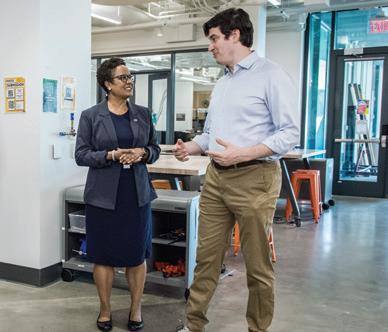
Is it safe to walk or ride a bike in Claremont?” asks The Claremont Courier. In the Feb. 9 article, Paul Steinberg talks about Claremont Streets for People, an organization that’s encouraging the city to establish a comprehensive master plan for pedestrian and bicycle users. On campus, Steinberg, professor of political science and environmental policy and holder of the Malcolm Lewis Chair of Sustainability and Society, was named a Community Engagement Faculty Fellow by the College’s Office of Civic and Community Engagement. He is working on the project “From Apocalypse to Empowerment: Reframing Climate Action.”
Medical technologies like x-rays, ultrasound and MRI often embody already existing cultural and

Mathemagician Art Benjamin continues to spread his love for math to audiences around the world. He performed for over 2,000 students at the Manipal Institute of Technology in India during a MathMagic Show in March. Benjamin performed a variety of captivating tricks that emphasized that math is not just
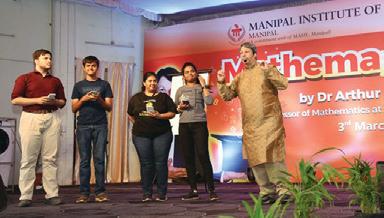
SUMMER 2023 11 COLLEGE NEWS
President Nembhard and Matt Spencer
Faculty Updates, continued
about numbers and formulas but creativity, logic and problem-solving. School officials reported, “The one-hour show was a spectacular success, leaving the audience awestruck with its intriguing magic tricks and mathematical feat[s].”
Lisette de Pillis, the Norman F. Sprague Professor of Life Sciences, was invited to give two talks during April and May. At the USC Southern California Systems Biology meeting, where she was the only invited speaker not from an R1 or research institution, she spoke about the new SARS-CoV-2 model she developed with biotech startup Aditxt Inc. At the University of Arkansas in Fayetteville she addressed a general audience to open the 48th annual spring lecture series. In her talk, she explored how the power of mathematical modeling could be harnessed to answer challenging questions that may at first seem unsolvable, like: Can an overflowing bathtub help us figure out how to achieve herd immunity in a pandemic?
At the 2023 Institute of Electrical and Electronics Engineers Conference on Artificial Intelligence, Weiqing Gu presented her insights on explainable deep machine learning methods in detecting diseases. By enhancing interpretability and transparency, Gu believes that we can build trust in artificial intelligence systems and make more informed decisions in healthcare.
Spring Emeriti Dinner

A gathering in April brought together former HMC faculty members and their spouses. Back: Patrick Little, Judy Little, Patricia Sparks, Dan Petersen, Richard Phillips, Joan Phillips, Richard Haskell, Louise Remer, Don Remer, Robert Wolf, Charleen Krueger, Kerry Karukstis, Hal Barron. Front: Nancy Hamlett, Sam Tanenbaum, Carol Tanenbaum, Lissa Petersen, Elizabeth Davis, Jerry Van Hecke ’61, Kathy Kobayashi.
For mathematics professor Francis Su, part of what makes math interesting are philosophical or spiritual ideas it presents like, “What does it mean to be infinite?” and, “What does forever mean?” He spoke about his wonder for math on the Dialogue on Science, Ethics, & Religion program.
Physics
In Memoriam
During a Mudd Talks event in June, Sharon Gerbode shared her childhood fascination of the winding helices of tendrils and the living springs they seem to form. As a physicist, she studies these coiling appendages and learns how their characteristic corkscrew shape affects their function. Plants, she’s discovered, have much to teach us about physical systems. Students in her lab are investigating a new twist: the blooming and rolling of morning glory flowers. Her work has been supported by the Research Corporation for Scientific Advancement, and her research has been featured on NPR’s Science Friday and on the Harvey Mudd YouTube channel.
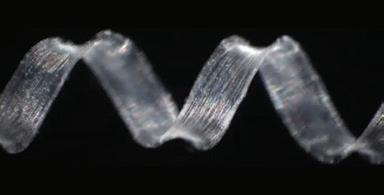
Eldred Frank Tubbs, a longtime resident of Claremont, died March 21, 2023. An Army veteran, he graduated from Carnegie Institute of Technology (now Carnegie Mellon University) in 1949 and earned a PhD from Johns Hopkins University in 1956. After a period in industry, he joined the Harvey Mudd College faculty in 1963 as professor of physics, continuing there until 1979. During that period, he was involved in laboratory measurements of quantities related to astronomy both at Harvey Mudd and as a visiting scientist at Harvard.
In addition to teaching and administrative duties, he collaborated with Graydon D. Bell on the absolute measurement of spectral-line strengths. The results of this research were used in work done at Harvard Observatory in collaboration with Martin C.E. Huber on solar iron abundance. As part of his teaching duties, he developed several innovations in lecture demonstrations and student laboratory experiments. Among the latter was a system of digital modules for instrumenting experiments in introductory physics laboratories.
He worked at Jet Propulsion Laboratory (1979–2005) and taught in the laser technology program at Pasadena City College for 10 years.

HA R VEY MUDD COLLEGE MAGAZINE 12 COLLEGE NEWS
Two prestigious annual awards go to similarly named scholars Si/ydney Sweep
Watson Fellow
As the recipient of a Thomas J. Watson Fellowship, Sidney Taylor ’23 will work alongside artists and engineers to discover how they ignite civic imagination through large-scale, public art creation. Taylor receives $40,000 for her project, “How Art Builds Community, How Communities Build Art.” During 12 months of travel, she’ll visit Canada, Spain, the United Kingdom, Australia and Taiwan “to join teams of artists and engineers to learn how to bring epic large-scale sculptures to life.” Along the way, she’ll explore how collaborative makerspaces foster connection and unite people and ideas.
Taylor was inspired to apply for the Watson by her experiences before and during her time at Harvey Mudd. During high school, she worked at a large-scale community makerspace in Reno, Nevada, called The Generator. With a team of artists and engineers, she helped build the Space Whale, a 50-foot-tall steel and stained-glass sculpture of a mother humpback whale and her calf now installed in the Reno City Plaza. At
Sage Advice
The new Entrepreneurship class by Kash Gokli, Oliver C. Field Professor of Manufacturing Practice and Engineering Economics and director of entrepreneurship initiatives, is yielding promising businesses. In April, Harvey Mudd entrepreneurs won three of the four top spots in the SageTank pitch competition run by Pomona Ventures, an organization of students from The Claremont Colleges. Winners received funding to invest in their company, and all competitors received publicity, networking opportunities and a jumpstart from the accelerator program. All top teams, including the third-place finisher from
Harvey Mudd, she’s spent a lot of time in the makerspace building customized items, like a motorized couch. Taylor has also worked with engineering professor Kash Gokli as a Riggs Fellow conducting applied and lab research and was on the 2022 first place team that won the technical paper competition at the West Coast Industrial and Systems Engineering Conference. She served as VP mechanical for MuddSub, the student underwater robotics club, played intramurals with her dorm and ran with the 5C Running Club. In 2021, she received HMC’s Outstanding Emerging Leader award.
While in Scotland, she’ll pursue another passion: Scottish country dancing. “I am also really excited about all the awesome people I will meet.”
Goldwater Scholar
Sydney Porto ’24, an aspiring physicianscientist, received a Barry Goldwater Scholarship, the most prestigious national award for undergraduate STEM researchers that covers the cost of tuition, fees, books, and room
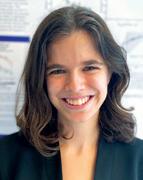
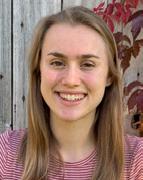
and board up to $7,500 per year.
A chemistry and biology major with a classics concentration, Porto conducted research at Harvey Mudd during her sophomore year with Associate Professor of Biology Danae Schulz, who studies the African trypanosome, to understand the changes that occur when the parasites go from expressing the variable protein in mammals to the invariant protein in flies. With Hannah Betts ’23, Porto tested an endogenous overexpression method that could potentially be used in future genetic screens.
Beginning in summer 2022, Porto worked in the lab of Michael J. Lee in the Department of Systems Biology at the University of Massachusetts Chan Medical School. There, she studied mechanisms of lethality in non-small cell lung cancer cells following the application of growth factor targeted therapies. She continued work in the Lee Lab this summer.
In addition to her time in the lab, Porto worked at the Harvey Mudd Writing Center as an Academic Excellence biology tutor. She plans to pursue an M.D./PhD in the field of cancer biology so she can work as a physician-scientist and conduct clinically relevant research in the field of oncology.
Pomona College, had participated in the Entrepreneurship class, which is open to all Claremont colleges students.
Winning Mudders
1st place ($5,000) | Axolotl Audio Devon Overbey ’24, Pierce Gruber ’25, Xander Fries ’24. Axolotl Audio uses audio from a microphone to detect the speed of passing cars and transmits that data to the cloud, enabling HOAs and cities to continuously collect speed data on dangerous roads to make streets safer.
2nd
Mau Brave Guzman ’25, Dominick Quaye’25, Ket Hollingsworth ’25. Brakesafe is an installable automatic braking system for motor vehicles that utilizes an opensource algorithm capable of detecting imminent collisions, pedestrians and red lights.
Ayman Abdellatif ’24. Athena Network is a mobile-based application that supplies students with valuable resources to get the most out of their college career.
SUMMER 2023 13 COLLEGE NEWS
place | Brakesafe
4th place | Athena Network
Research Recognition
countries. Her senior thesis with Jamie Haddock, assistant professor of mathematics, is on the sensitivity of a Laplacian family of ranking methods. Chang will pursue a PhD in industrial engineering and operations research at Cornell University’s School of Operations Research and Information Engineering.


Two Astronaut Scholars
National Science Foundation Graduate Research Fellowship

Throughout most of her undergraduate career, Albany Blackburn ’23 has worked with Brian Shuve, assistant professor of physics, investigating the sensitivity of a collider search method using long-lived particles that explore a wide range of dark matter models. For her senior thesis, she studied the cosmological implications of a model in which dark matter interacts with normal matter via an axion-like particle. Last summer, she worked at University of Colorado Boulder with physics professor John Cumalat to test the radiation hardness of parts planned for installation into the Compact Muon Solenoid experiment at the Large Hadron Collider. During summer 2021, she studied how machine learning methods could help researchers calculate the states of neutron stars with Jeremy Holt, a nuclear theorist at Texas A&M University. She also spent a semester working with Leah Mendelson, HMC assistant professor of engineering, developing software for threedimensional fluid flow analysis. Blackburn will attend graduate school at UC Berkeley to pursue a PhD in physics.
Claire Chang ’23 has done research with TJ Tsai, associate professor of engineering, on signal processing. Their work on a novel algorithm culminated in a publication in the Applied Sciences Journal. She also worked with Susan Martonosi, professor of mathematics, on an operations research project to model the procurement and pricing of hexavalent pediatric vaccines for low-income
As part of his senior thesis, KausikDas’23 modeled Janus particles in fluid under the guidance of Ali Nadim, professor of mathematics at Claremont Graduate University. Das has been advised by mathematics professor Dionisios Margetis as part of a Research Experience for Undergraduates at the University of Maryland, where he studied hydrodynamic electrons in graphene. He also worked on models for osteocytes (bone cells) with Jared Barber at the Indiana University-Purdue University Indianapolis applied mathematics REU and, at HMC, explored the motion of a dolphin tailfin at a water-air interface with engineering professor Leah Mendelson.
Computing Research Association, Honorable Mention
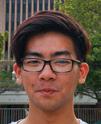
Cynthia Hom ’23 worked in the AMISTAD lab (George Montañez) on several projects: analyzing the survival advantages of intention perception in virtual agent games, synthesizing results for an algorithmic search framework that unifies machine learning and artificial intelligence algorithms, and proving a bound that allows use of a statistical hypothesis test with estimated quantities.
Malia Morgan ’23 worked with Zach Dodds to help redesign an introductory computer science class for non-computer science majors and to do data analysis and visualization work on over 10 years of educational data. She’s also worked in Jim Boerkoel’s HEATlab (Human Experience & Agent Teamwork) on an algorithm that offers a way to redefine the role of humans on human-robot teams to make them more active members and create more flexible plans. For a research project in Calden Wloka’s Lab for CATS (Cognition and Attention in Time and Space), she examined attention in action recognition neural network models and compared it to human attentional behavior.
Exemplary academic performance, ingenuity and a unique aptitude for research are some of the traits of the elite group of Astronaut Scholars for the 2023–2024 academic year. In addition to scholarships (up to $15,000), they’ll network with astronauts, alumni and industry leaders, have professional development opportunities and present their research at a technical conference.
Ryan O’Hara ’24 is a transfer student double majoring in environmental robotics and math/ computer science. He is founder of a direct air capture solution and has created a robot that floats on the ocean and uses hydropower and biochar to sequester carbon dioxide. He was inspired to develop the startup (Apsis Robotics) during Kash Gokli’s Entrepreneurship class. He has since received the 776 Fellowship, a $100,000 grant to help him launch the company.
Lucien Tsai ’24, a physics major, is inspired by the vision of a world where sustainable materials can replace current energy-intensive materials. Tsai works in the Physics of Soft Matter Lab, advised by Mark Ilton, where he performs novel dynamic mechanical analysis measurements to understand the viscoelastic behavior of soft matter and the various theories developed to model their mechanical properties. He has presented this work at conferences, including the American Physical Society March Meeting, and is working to publish a paper about it.

HA R VEY MUDD COLLEGE MAGAZINE 14
COLLEGE NEWS
See you in class, Grandma
Interview by Judy Augsburger
last spring, engineering major mikayla Mann ’25 and her grandmother, Claremont resident Penelope Mann, took Feminism and Science together. The course was taught by Pomona College professor Sue Castagnetto and is part of the Napier Initiative. This partnership between Pilgrim Place Retirement Community and the 5Cs offers intergenerational courses centered on social justice. Five elders participated in the class along with 15 students from the 5Cs.

Whose idea was it to take the class together?
Penelope: I was interested in taking a Napier class, and then saw the topic and thought, gosh, you know, there's Mikayla, right there at HMC. Let me just ask her if she'd be interested. I’m not a scientist, I’m a retired minister, but I was part of that wave of feminism in the late ’60s and ’70s. We were advocates for exactly what Mikayla's benefiting from now. It was a chance to see my own granddaughter benefiting from the efforts I was part of. And then, you know, it was a chance to hang out with Mikayla more often!
Mikayla: When she asked me, I thought, how many people get to say they take a college class with their grandma? It sounded like a great opportunity. Also, I was really intrigued by the title, Feminism and Science because, well, I am a woman in science! It’s a philosophy class, and it’s my first foray into the social justice side of women in STEM. The class focuses a lot on discrimination against women in the STEM workplace, historically and in the present. I saw how I could apply that to my own life.
What was it like to be in class together?
M: It was definitely a unique class experience, because there was obviously a gap in the
experiences of the elders versus the college students. Hearing the elders talk about the wave of feminism they experienced in earlier decades was really interesting. Also, I look to my grandmother as someone whose perspective on the world I want to emulate as I move through life. So, I really liked hearing her thoughts, especially on the more difficult issues that we considered.
P: We often sat beside each other in class. So when there were small group discussions, we'd be in the same group. It was just nice to hear how Mikayla thinks about things. It’s encouraging to see young women in science being able to articulate positions, but not intimidate someone else and not be intimidated when challenged.
What class topics were especially interesting?
P: We looked at how women have been kept out of the sciences historically and are still kept out today in a number of ways. I'm not surprised that women’s research wasn’t valued in the past, but we saw that there's still a lot of instances where women aren’t taken seriously as researchers.
M: And we looked at the stereotypes as to why women are still cut out of science, such as women are more emotional or less analytical. It amazes me that even I have those implicit biases in my subconscious sometimes, even though I'm a woman in science and both my parents are in engineering (Joshua ’94, P25 and Michelle Mann ’93/94, P25).
P: Another thing we discussed was, if there were more women in science, would they ask different questions and do different research? In some articles we read, we discovered that when women are involved on teams, there is more collaboration, more listening and ideas brought in, which are all qualities of the best functioning teams. And in teams with more women, more questions are raised about how the science will affect society.
M: In class, we called those techniques of practicing science that you just described “feminist science.” I see it a lot at Harvey Mudd—in the mission statement about impact on society and in our general practice of collaboration, asking larger questions and viewing the world from a broader point of view. It's what we call a holistic perspective as opposed to reductionist—looking at how all the parts work together.
Did you do homework together?
M: She didn’t have to write the essays! (laughs)
P: Those are the usual guidelines for the elders taking Napier classes (laughs). We don't have to take the exams or do the essays, but we have to do all the reading and preparation to participate in class.
M: But we debriefed about the class a lot. And now we have more things to discuss together. It definitely brought us closer.
SUMMER 2023 15 COLLEGE NEWS
An intergenerational course brings family members together
MY MUDD LIFE
Photo by Dominic Indolino
Capstone Roundup
These projects demonstrate some of the many academic achievements during 2022–2023. View more projects in the online document at bit.ly/HMCcapstone23
Mathematics
1. Graph Learning on Multi-Modality Medical Data to Generate Clinical Predictions

Student: Justin Jiang
Advisor: Weiqing Gu, McAlister Professor of Mathematics
Health care presents an exciting new source of data for machine learning researchers, as electronic health records become more and more prevalent for record keeping in hospitals around the world. These digitized health records provide a wealth of data for the curious machine learning researcher, but obstacles arise in the form of the lack of public benchmarks and inconsistent data handling. Jiang explored novel machine learning techniques, specifically graphical methods, to build a prediction engine using publicly available datasets.
Biology
2. Flapping-Wing Flight Kinematics to Maximize Lift and Minimize Drag Using a CFD Model

Student: Occam Kelly Graves
Advisor: Anna Ahn, professor of biology
For small fliers, flapping-wing flight is more energetically efficient than the fixed-wing flight of planes. Efficient flight requires a balance between producing lift which keeps birds aloft and minimizing drag which slows forward flight speed. Many factors contribute to wing efficiency; wing size, shape and movement play critical roles in producing the required forces during flight. Graves examined wing movements including wingbeat frequency, angle of attack and wingbeat amplitude. Using a computational fluid dynamics model of a simplified bird, the lift and drag produced during flight is calculated for OpenFOAM simulations with different wing movements. This model can be used to predict how wing angles and wingbeat frequencies affect aerodynamic forces in flapping flight.
Physics
3. Dislocation Behavior During Granule Rotations
Student: Eric Corona
Advisor: Sharon Gerbode, associate professor of physics
When a crystal grain is enclosed within another crystal, the interface between the two regions, the grain boundary, shrinks as the enclosed grain dissolves. In colloidal crystal experiments, Corona observed that hexagonal particle clusters, or “granules,” rotate to switch from one crystal orientation to another. Grain boundaries are composed of dislocations, and their behavior during granule rotation is complicated by the presence of rapidly changing crystal orientation. The conventional prediction of grain dissolution is that dislocations will glide until they meet and interact through dislocation reactions or dissociations. However, more complicated behavior is observed in which dislocations move using both glide and climb, despite the high energetic cost of climb.

HA R VEY MUDD COLLEGE MAGAZINE 16 RESEARCH
2 1 3
Simulated air flow pattern in the wake of a simplified bird model with flapping wings
Crystal grain loop
Shanahan Project
4. Smoke Mask Rescue Drone
Student: Dominick Quaye, Mauricio Bravo, King Osei
Advisor: Leah Mendelson, assistant professor of engineering
The team aimed to construct a quadcopter to give residents emergency smoke masks during fires by entering through windows. Since more than 80% of fire deaths are from smoke inhalation, getting masks to people in burning buildings as fast as possible is essential. The benefit of using a drone to deliver masks is that it can rise multiple stories in seconds, getting to people far faster than firefighters without putting anyone at risk. The team constructed a 10-inch FPV quadcopter with a visible spectrum camera, thermal camera and mask dropping casing capable of holding two masks. The casing uses a quick-release and sliding electrical contacts such that additional pairs of masks can be mounted on the drone in seconds, allowing for rapid backto-back deliveries to victims.
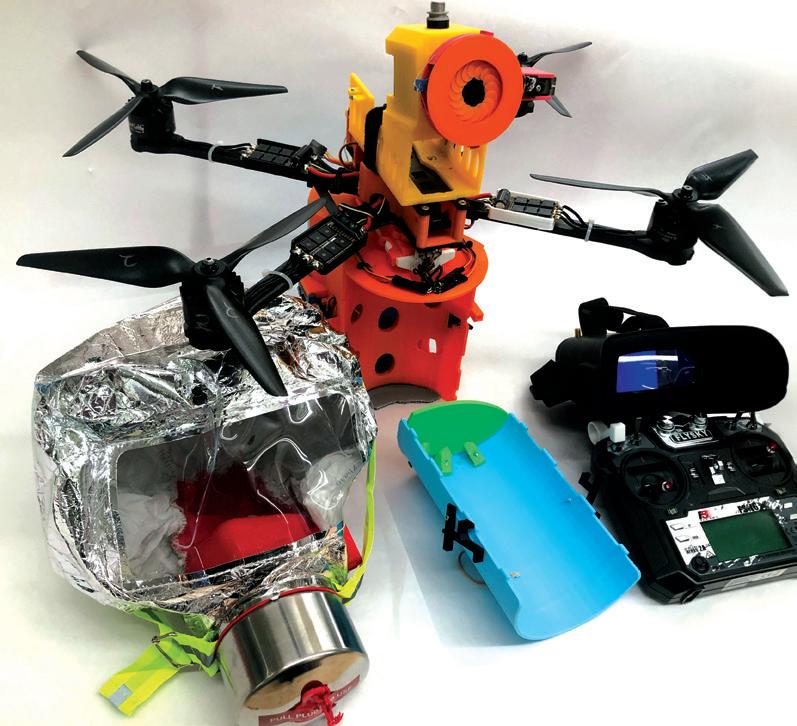
Mathematics
5. Seize the Means of Instruction: Exploring the Constraints on Math and Physics Teachers
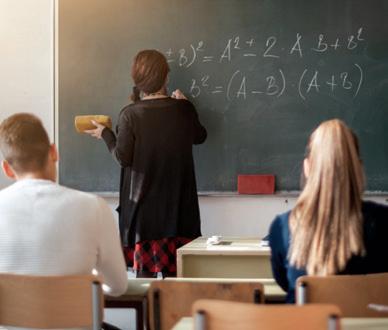
Student: Bradley Gonmiah
Advisor: Jon Jacobsen, Kenneth and Diana Jonsson Professor of Mathematics; chair, Department of Mathematics
Gonmiah examined constraints on K–12 math and physics educators and the impact on marginalized students. Through a Marxist analysis and systems thinking approach, he focused on the role of teachers in the education system and how their constraints perpetuate cycles of inequality. By shifting the focus from student-centered approaches to a broader understanding of the education system, the research aims to identify potential solutions for creating a better society that values math and physics education for all.
Chemistry
6. Simulating Urban Grime Chemistry Using Cellular Automata Models
Student: Ali Talib Saifee
Advisor: Sarah Kavassalis, postdoctoral scholar in interdisciplinary computation; assistant professor of climate and chemistry
Urban grime, a complex film formed by the deposition of organic and inorganic pollutants, can be an important medium for heterogeneous chemistry in cities. Experimental evidence from ambient grime sampling and laboratory-made proxies have uncovered a wide range of chemical compositions, relevant reactions and thus highly varied potential consequences for urban air quality. Explicitly modeling this chemistry is challenging, given the multiphase nature of grime. Saifee presented progress on a novel modeling framework based on cellular automata that can simulate the deposition and partitioning of gases and aerosols onto surfaces and their subsequent chemical reactions. This model is used to identify the ambient conditions under which urban grime can act as a NOx sink/source.

SUMMER 2023 17 RESEARCH
4 6 5
Data Solutions and Sticky Situations
With presentations returning to in-person this year (plus an online viewing option), students shared solutions to 41 Clinic projects. Teams built a working prototype or helped advance the industry standard in research and development. The business value of Clinic outcomes often leads sponsors to return (more on this year’s Milestone awardees in the sidebar), and students apply their learning in creative ways; nearly 80% of last year’s Clinic sponsors said they will incorporate the students’ results into pre-product R&D or use them to improve an existing product.
Engineering Clinic
1. Delivery System for Transcatheter Heart Valve Replacement Nininger Medical liaisons: Daniel Anderson ’99, Andrew Schombs, Dr. Lowie Van Assche
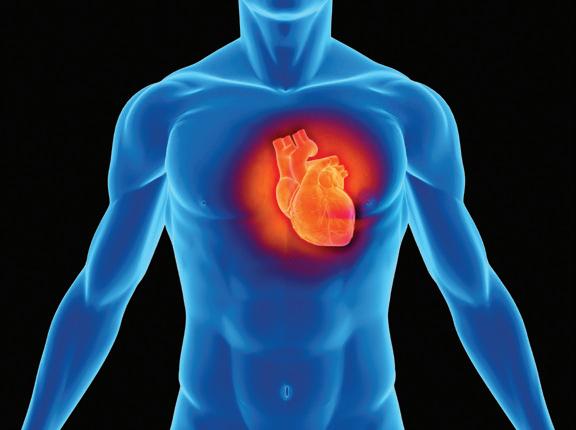
Students: George Wang, Isabel West, Sydney Cornell, Arya Mididaddi, Elijah Adamson
Advisor: Angela Lee ’05
The Nininger Medical Clinic team developed a transcatheter tricuspid valve replacement device for pre-clinical studies. As a grant-funded start-up, Nininger Medical Inc. is designing a delivery system to remedy tricuspid heart valve disease. This spring, the team constructed and integrated the new mechanical stops, valve insertion mechanism and catheter-to-valve frame connection that were designed during the fall semester. The team used various 3D printing technologies as well as the HMC shop facilities to prototype these designs and conduct strength and durability tests.
Engineering Clinic
2. Automation of Gummy Supplement Sachet Filling

We Pack it All liaisons: Greg Pagani ’20, Natan Bershtel ’01, Vanessa Jimenez, Patrick Green Students: Elena Anderson, Meredith Bloss, Izzy Jackson, Annie Elliott, Jordan Stone, Kevin Box, Ruth Mueller Advisor: Lori Bassman
The WePackItAll Clinic team designed a system to fill sachet packages with small counts of one to 10 gummy supplements. Due to the stickiness of gummies and high-accuracy needs, sachet filling is currently done by hand, which introduces inconsistencies, tedious work and potential safety hazards. The team designed and built a system that interfaces with a horizontal form fill seal machine to fill gummies into sachets. The final product is an automated prototype that singulates, counts, groups and accurately dispenses gummies into sachets.
Computer Science Clinic
3. Automatic Video Scene Extraction and Annotation Tool for Customer Experience Enhancement
DirecTV liaisons: Peshala Pahalawatta, Rudy Lowenstein
Students: Marcos Acosta, Aldrin Feliciano, Isabel MacGinnitie, Ruth Mekonnen, Alina Saratova, Daniela Sechen
Advisor: Calden Wloka
DirecTV offers streaming and satellite TV services that curate content for its viewers. DirecTV aims to automate generation of personalized football highlight reels, so fans who miss a game should be able to keep up-to-date with their favorite teams and players in real-time without the need for manually curated content. To achieve this, the Clinic team created a dataset, which pairs a full-length game with highlight scenes and applied machine learning models to label football plays as either highlight or non-highlight.
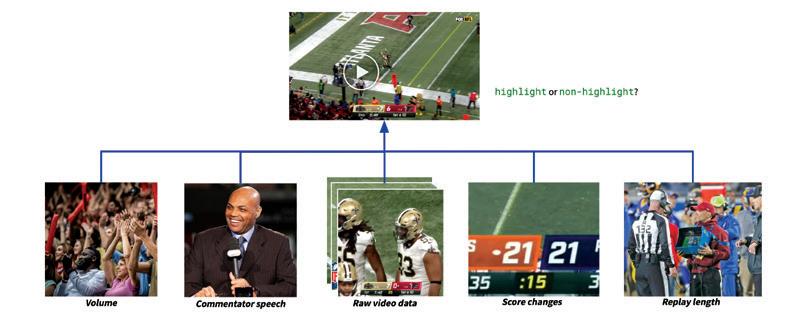
HA R VEY MUDD COLLEGE MAGAZINE 18 CLINIC
3 2 1
Computer Science Clinic
4. Data-Organizing for Labor Action
Unite Here liaisons: John Lessandrini, Jen Kim, Doug Reich ’07
Students: Zoe Tokheim (PM), Megan Maley, Cooper Nissenbaum, Vera Reséndez, Nathan Roche
Advisor: Erin Talvitie
Unite Here is a labor union representing 300,000 workers across the United States and Canada. Although the union has extensive experience in labor organizing, it recognizes the potential for improved data infrastructure to strengthen the decision-making processes of labor campaigns. The team helped expand Unite Here’s dataorganizing capabilities through the development of a centralized, accessible data visualization tool that will allow a wide range of users to make data-informed decisions.

Milestone Awardees
The College celebrates returning organizations for participating in the Clinic Program and investing in its students and the future of STEM.
35 Projects
National Aeronautics and Space Administration (NASA) has been a Clinic Program sponsor since 1972, challenging student teams with projects related to space exploration. As Mars exploration expands, JPL and NASA are seeking to bring materials from Mars to Earth, an exercise with potential risks. This year’s NASA Engineering Clinic team built a “safety case” that diagnoses the severity of a range of possible threats to Earth from any returned samples.
Engineering/Math Clinic
5. Modeling Green Hydrogen Production and Trade Center for Strategic and International Studies liasons: Joseph Majkut ’06, Douglas Arent ’82 Students: Raj Sawhney, Ross Hibbett, Khaya Kingston, Makenna Parkinson, John Hearn Advisor: Jon Jacobsen
If green hydrogen hydrogen produced via electrolysis of water using renewable energy were to be widely available and cheap to produce, it could be key to decarbonizing industrial production and other end uses. Countries around the world are making investments to become green hydrogen producers and exporters. Students developed a production model that incorporates relevant energy, electrolysis and hydrogen resource and technology costs to allow them to estimate the levelized cost of hydrogen and the feasibility of hydrogen trade between geographically separated nations.
Sandia National Laboratories, a Federally Funded Research and Development Center and a contractor for the U.S. Department of Energy’s National Nuclear Security Administration, is a premier science and engineering laboratory for national security and technology innovation.
The lab is researching barium titanate (BTO), a ceramic material with many applications in electronics due to its ferroelectric properties. Members of the 2022–2023 Engineering Clinic team used density functional theory to perform a computational study on BTO and its interaction with ligands, such as hydrogen, water and tert-butylphosphonic acid. They explored the interactions on the titanium dioxide-terminated surface of BTO and explained the effect on the ferroelectric properties of the material.

10 Projects Proofpoint Five Projects
Juniper Networks
Tradeweb
SUMMER 2023 19 CLINIC
4 5


Eight Great Things to Know About President Harriet Nembhard
Family legacy, groundbreaking research, lessons from Covid and ways she’s partnering for future possibilities
Written by Stephanie L. Graham Portrait by Jeanine Hill
a u.s. air force captain turned commercial pilot gazes skyward with his daughter as planes take off from Atlanta’s Hartsfield International Airport. The young girl points out the different airplanes as they zoom overhead: B-747. Super DC-9. DC-8. Super B-727. Lockheed L-1011. Douglas DC-10. She knows the engines, too. But what she really wants to know are things like: How does the luggage get from the sidewalk to the planes? Why are the small planes parked on this side of the airport and the large ones there? How do pilots know which flight attendants are going to fly with them? Systems questions.
In this snapshot from the 1970s, the father is Charles Black and the daughter is Harriet, who will pursue her curiosity of engineering management and take on increasing leadership roles on her way to becoming the sixth president of Harvey Mudd College.
Teacher’s Kid
In one of her first meetings with the Harvey Mudd community, Harriet (Black) Nembhard shared that “education and the academy are literally in my genes.” The product/legacy of four generations of
educators, Nembhard finished high school at 16 and, at the encouragement of her mother, Helen Eastman Black—an early childhood teacher turned bank executive—and her high school science teacher, headed to California to pursue the 3/2 management-engineering program at Claremont McKenna College. In 1991, she received bachelor’s degrees in management-engineering from CMC and industrial engineering from Arizona State University. A range of important experiences during this time—manufacturing operations at Pepsi, operations at Dow Chemical, manufacturing at General Mills, operations modeling at American Airlines Decision Technologies—shaped the work she pursued in her doctoral research.
She earned a PhD in industrial and operations engineering from the University of Michigan, where she attended with her husband, David Nembhard (both have PhDs in this area). Her work has led to many advances, including simulation tools for assessing emergency department patient flow, improved manufacturing processes for medical devices and a sensor-based system to conduct early screening of Parkinson’s disease. These contributions helped improve quality of
SUMMER 2023 21
care for thousands of patients and framed a groundbreaking co-authored textbook, Healthcare Systems Engineering.
“For 20 years, the work I did as an academic researcher was tied to many of the challenges motivated in manufacturing and healthcare systems,” says Nembhard. “I consistently had partnerships with industry and providers that extended the impact of my lab’s work. As I became more senior in academia, there was a natural progression of increasing responsibility for larger teams, a research institute and professional societies. This led to being tapped for academic leadership roles.”
Claremont Connection
Having a Claremont colleges connection, along with her academic and administrative experience, set Nembhard apart from other candidates for the Harvey Mudd presidency, says Jim Bean ’77, chair of the HMC Board of Trustees and the Presidential Search Committee. Nembhard was a CMC alumna trustee for three years and served on its inaugural Integrated Sciences Advisory Council, working with former HMC computer science professor Ran Libeskind-Hadas, founding chair of the Kravis Department of Integrated Sciences.

Nembhard says, “Being on the board was quite formative and insightful. It was a chance to come back and contribute to addressing some of the challenges that are facing a distinctive liberal arts college. I've come to understand and experience that being on such a board is really a team sport. It was a master class in leadership.”
Academic Leadership
Prior to her work on the CMC board, Nembhard was co-parenting three children while holding academic leadership positions at Oregon State University and The Pennsylvania State University. At Penn State, she was founding director of the Center for Integrated Healthcare Delivery Systems, an interdisciplinary research hub that uses applied statistics and operations research to improve the efficiency and quality of healthcare delivery to patients.
She built the center from the ground up, from infrastructure to involvement of the faculty, training of students and connecting with healthcare industry partners. It’s still going strong. “In one project, our team studied the early detection of Parkinson's disease. We used non-invasive sensors to capture thousands of data points and use machine learning to flag
that for potential onset of Parkinson’s that could then be examined clinically with a team of neurologists.”
Most recently, she worked at University of Iowa, where she was dean of the College of Engineering, managing a budget of $100 million and overseeing the academic programs, departments and institutes that support more than 2,000 students. She led initiatives related to Covid recovery, faculty hiring, student leadership and ethics, and improving the college’s research profile.
“As a dean in a university setting, you have many of the same responsibilities as a college president—strategic planning, ensuring proper management of the institution’s finances, promoting excellence in teaching and research, serving as the public face of the school and, of course, institutional fundraising. In a larger university setting, it can sometimes be challenging to create the kind of impact you hope to achieve as quickly as you would like,” says Nembhard. “As Harvey Mudd president,
I expect to have a much deeper role in leading the community as we engage in real, in-depth conversations around questions such as, What are our best ideas? and How do we use those to advance the College and its mission?
At This Moment
“I firmly believe that we must create the presidency that Harvey Mudd needs for this moment in its history,” Nembhard says. “I hope that as a community, we can begin to explore and engage with the possibilities for our future, being sure that we are always looking toward those things that make Harvey Mudd distinctive, while focusing on our areas of opportunity.”
Nembhard is intrigued by the potential to affect the next-level impact of a united STEM and liberal arts education—after all, it’s what formed her. “I have to wonder if this is what my experience—starting in Claremont and then continuing to work in very interdisciplinary and collaborative ways—has all been for.”
HA R VEY MUDD COLLEGE MAGAZINE 22
JEANINE HILL
President Nembhard on campus with Gregory Wickham ’26, Marcella Todd ’25 and Valentina Watson ’25
But w8!
Teaching family

“My Great Grandma Mary started teaching in a one-room schoolhouse in Georgia in 1906. We've had teachers and educators in our family for every generation since. A true hero to me is my Grandma Harriet; she taught in the Atlanta Public School system for over 40 years. She was able to assist me, so I only had to take off one semester at Arizona State University and complete the two-year portion of the CMC dual degree in December 1990. She taught me so much about faith, family and perseverance, and inspired me to keep going when times get tough.”


CMC student experience
“The experience that stays with me is that I grew confident that I could do more than one thing at a time. One thing that was true when I was a student and that I feel remains true today is The Claremont Colleges’ commitment to ensuring that our students have the best academic and co-curricular experiences possible during their time here. I’m very much looking forward to talking with and learning more from Harvey Mudd students about their experiences and their suggestions for ways that we can partner to improve on these experiences even further.”
Parenting using systems principles
“We have three children, who are now in their 20s, and who we parented using systems principles. For example, when they were little, they each had two specific colors of eggs to find for Easter egg hunts. The oldest had the colors that were well hidden, the middle had the colors that were a little easier to find, and the youngest had the colors that were nearly out in the open. This was a homespun version of capacity planning. Now that they are older, they can also use this experience to explain the difference between equitable versus equal treatment.”
SUMMER 2023 23
1
2
Nembhard studies from a calculus textbook one she still has in her Phillips Hall dorm room at CMC.
3
Mary Towles Barfield, Nembhard's paternal great-grandmother, earned her diploma and teaching certification along with 13 other class members in 1906 from Ballard Normal School in Macon, Georgia.
Children Charlotte (20), Naomi (22) and Olivia (26) and grandson, Kai, with Harriet Nembhard and David Nembhard.
There’s so much more to Nembhard’s multi-faceted life. Learn about other key events and people who have shaped her into the person she is today.
Quality 4.0
President Nembhard is a proponent of the Quality 4.0 concept, which aligns with Industry 4.0 technologies—such as artificial intelligence, cyber-physical systems and big data analytics—and has potential to improve student success, humanize education and empower academic leaders to create the culture change needed for transformation. “Quality 4.0 addresses the challenges that academic leaders face, from quality training to more technical challenges on the managerial side and has influenced the way that I lead. I think it offers a lot for academic leaders to contemplate.”
5COVID 19 leadership lessons

As a leader at University of Iowa during the height of the COVID-19 pandemic, Nembhard says she learned several important lessons.
1. Crisis communication. “The pandemic underscored that effective communication with students, faculty, staff, parents, and other key stakeholders was crucial.”
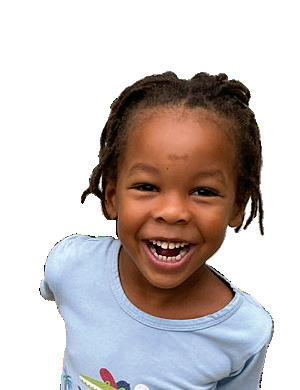
2. Digital transformation. “The pandemic forced us to quickly invest in technology infrastructure, online learning platforms and remote collaboration tools.”

3. Student engagement and support. “To deal with the pandemic, we had to devise new systems to provide virtual academic advising, counseling services and resources to support students’ mental health and well-being.”
4. Equity and access. “The pandemic highlighted existing inequities in access to education. We had to address the digital divide, ensuring equitable access to technology and internet connectivity for all students.”
5. Mental health and well-being. “The well-being of students, faculty and staff became a top priority. We had to expand mental health support, establish remote wellness programs, promote better work-life balance and relieve some of the tenure-track pressure with extended tenure clocks.”
High-flying fun
“I enjoy making paper airplanes and helicopters with my 5-year-old grandson, Kai. We have a few designs that we’ve made hundreds of times, with the Mighty Eagle being our favorite!”
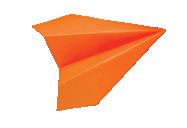
HA R VEY MUDD COLLEGE MAGAZINE 24
6 4 ERIK WIRTANEN/ASU
A worldly perspective
“I enjoy traveling—whether it be attractions close to home or big cities far away. So far, I’ve visited 41 of the United States, several Caribbean islands and 11 other countries. I recently went on the Claremont McKenna College Worldmeet trip to Reykjavik, Iceland. It brought a community together to learn about climate and sustainability through engaging conversations, faculty lectures, tours of geothermal power production facilities and expert guides explaining key aspects of the region. One of many highlights across the six magical days was a boat tour in Faxaflói Bay to see the puffins.”
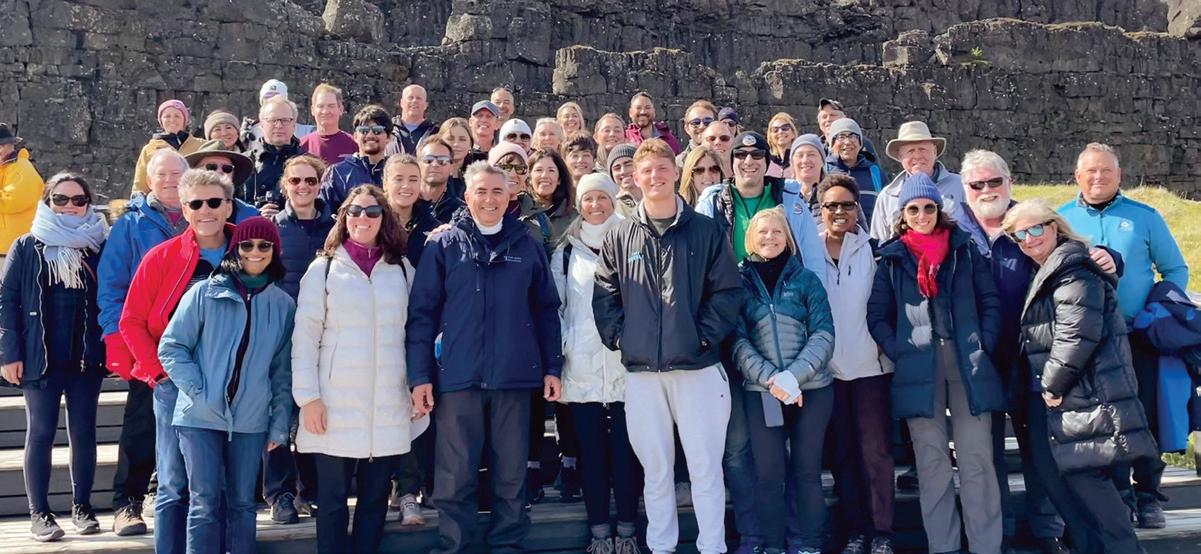
Healthy outlook
“You have to put the big rocks in first. You have to invest in yourself, in your health, in order to show up for your friends and family and be best able to carry out the work that you are doing. This sort of wellness and well-being is important to a community. As long as you’re healthy and able, hold yourself responsible for choosing joy and choosing optimism—those are the foundations for true success.”
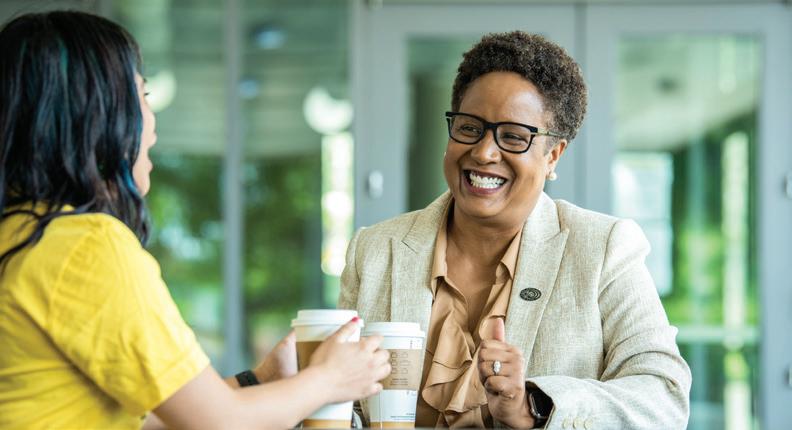
SUMMER 2023 25
7
CMC Worldmeet group at Thingvellir National Park, Iceland
8
The Physics Major Goes To China
Roger Cliff ’83 brings his insight into Chinese society, politics and the military to the U.S. Indo-Pacific Command
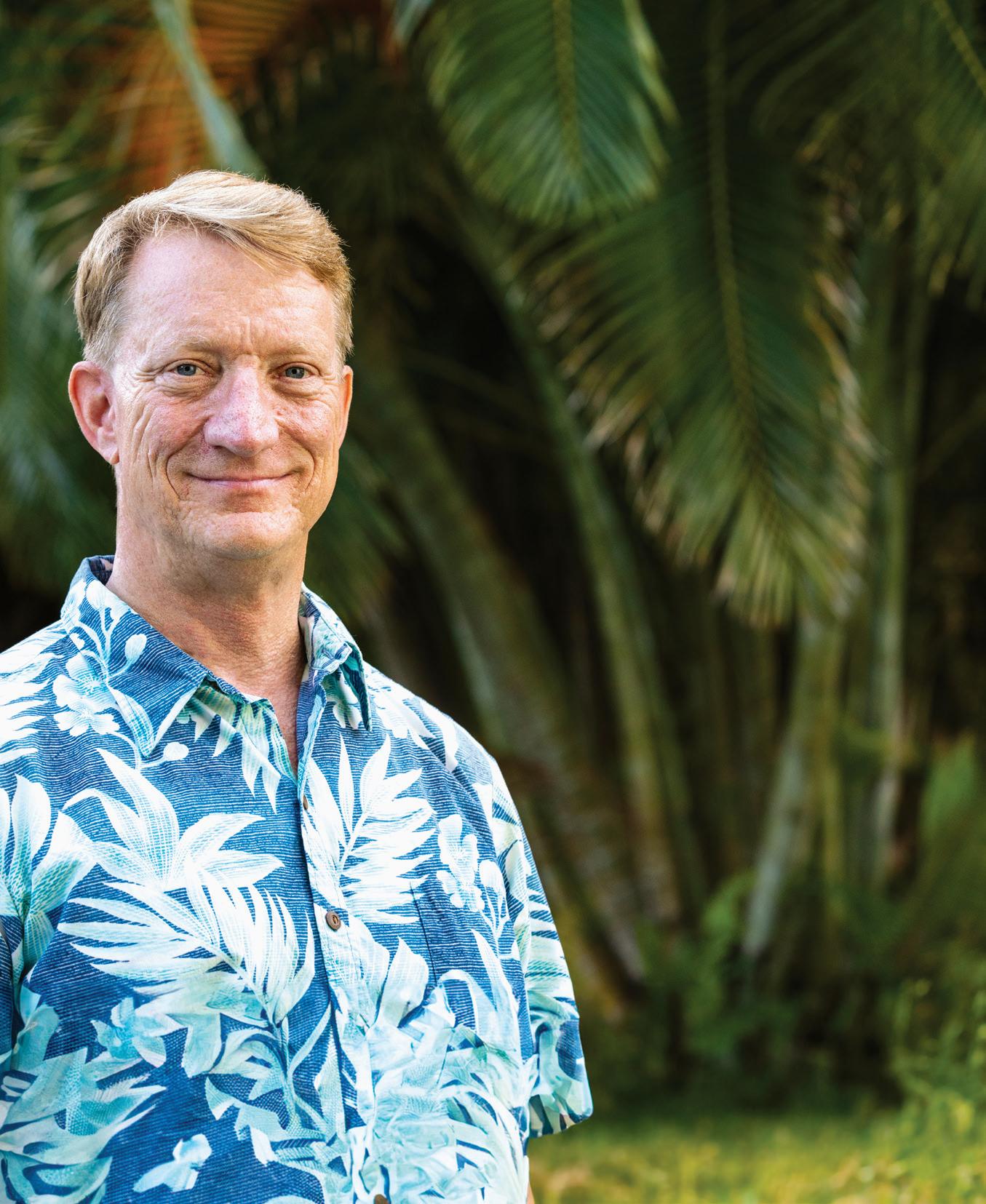 Written by Leslie Mertz
by Dana Edmunds
Photo
Written by Leslie Mertz
by Dana Edmunds
Photo
ith almost a fifth of the world’s population, a geographic surface area that rivals the United States and a swiftly growing economy and military, China has emerged as a major player on the global political stage and one that the U.S. government has sometimes struggled to fully understand. This is where Roger Cliff ’83 comes in.
Over the past 25-plus years, Cliff has conducted research and analysis for numerous public policy- and national security-focused organizations from the Rand Corp. and Project 2049 Institute to the Atlantic Council and Center for Naval Analyses. And, as of July 2022, Cliff is the senior defense intelligence analyst for China at the U.S. Indo-Pacific Command, the Department of Defense organization that oversees all U.S. military forces in the Asia-Pacific region as well as those in Hawaii and some on the West Coast. “I was brought in because they wanted someone who could provide an understanding of how China’s political, social and cultural background affects what it is doing in the region,” Cliff says.
China is certainly a diverse and complex nation, especially considering its rapid shift from a quite poor nation to a technological and manufacturing leader, and from a politically isolated country to one with a prominent seat at the global political and military table, Cliff says. “People who are new to the topic tend to jump to conclusions that may be based on pretty reasonable deductive logic, but people and nations and cultures are more complex than simple logic would dictate. So, I hope that I will bring some of that dimension to the job to supplement the people who are far more knowledgeable than I about the specifics of military operations.”
Cliff’s journey from the physics program at Mudd to China analyst and strategist had many twists and turns. “I chose Harvey Mudd because it was a place where I could get a first-class degree in physics, but still have time to spend on social science and the humanities, because I was interested in those things too,” he says. That broader interest led him to step outside the physics realm after he graduated. He took a job as an engineer with a defense contractor in San Diego while also enrolling in the China studies master’s program at the University of California, San Diego (UCSD). As part of the program, he spent two years studying at Peking University in
Beijing, which allowed him to hone his Chinese language skills and immerse himself in Chinese culture and society. Upon returning to the U.S., he began working with UCSD economist Barry Naughton, one of the top economists on China, and centered his thesis on technological progress in China’s steel industry.
World events during that period got Cliff thinking about a possible future in public policy. “We were still in the Cold War at that time, and in looking at U.S. foreign policy over the previous decades, it seemed that our policy was often misguided because of an inadequate understanding of the countries abroad that we were dealing with,” he says. “I believed we had to interact with them in a way that was both in our own interests, as well as in the broader interests of the world.”
Along those lines, he then sought a doctorate at Princeton University, where he concentrated on the relationship between China and Taiwan, and also lived a couple of years in Taiwan. It was during his doctoral years that tensions rose between China and Taiwan and led to the so-called 1995–1996 Taiwan Strait Crisis, during which China test-fired missiles into the waters around Taiwan. “All of a sudden, everyone became interested in China as a potential future military challenge for the U.S.,” he says. That included the Rand Corporation, a public-policy think tank that was launching a project to study China as a potential security challenge. Rand hired the newly graduated Cliff as a political scientist. “I focused quite a bit on China’s defense industries initially because I had a background in defense technology through my engineering job and in China’s steel industry as a master’s student,” he says. He also found that the Chinese military is a prolific publisher of its own research, ranging from the technical to the strategic, so his Chinese language skills became a great asset.
Since then, Cliff has continued moving from one compelling project to the next. He remarks, “When an opportunity to pursue an idea comes up, I have pursued it.”
His current position as senior defense intelligence analyst with the U.S. Indo-Pacific Command offered a way to influence U.S. policy but to do it a bit more directly. Most of his previous work involved doing research and writing detailed reports, he says, “but this is a job in an operational command, where the commander is making decisions every day about
where to send his forces, and every morning when he wakes up, he’s worried about whether a war with China has started. So, to be able to be here advising someone who’s in a position to actually affect the course of events is an exciting opportunity for me.”
Cliff is quick to point out that his influence only goes so far. “Even in this fairly senior position, I am still just one cog in a huge apparatus that is grinding along with its own momentum.” Still, he says, it is gratifying to have a voice at the table and affect public policy.
In reflecting on his journey from Mudd to senior defense intelligence analyst, he is aware his life has taken many turns. “Living abroad for a total of four years, traveling extensively throughout East Asia, learning a foreign language—this particular career path has led to a very different life experience.” While he knew he wanted to keep his options open by the time he left Mudd, he adds, “I couldn't have predicted or even guessed the way my career would take me. It has been exciting.”
SUMMER 2023 27
“ Living abroad for four years, traveling extensively throughout East Asia, learning a foreign language—this particular career path has led to a very different life experience.”
–ROGER CLIFF ’83
With such great feedback on our first gift guide in 2020, we’re back with some of your favorites as well as some new offerings from creative, entrepreneurial alums. Consider these potential gift items for the upcoming holidays or for any special occasion.
“Mountain Peak,” original blockprint | $30

Lauren Nishizaki ’14 is an artist and printmaker based in Seattle. She carves and prints original linocut blockprints inspired by the beauty of the Pacific Northwest and her Japanese American heritage. Many of her designs also appear on cards, locally-printed on eco-friendly paper and sold both online and in local stores.
Lauren Nishizaki Designs | www.laurennishizaki.com/shop
Custom woodwork, including wall art and tables | starting at $200

Kamau Waller ’18 owns and operates a woodworking business based in Houston, Texas. His passion for woodworking began during his time at Mudd, and he now expresses his creativity and ingenuity through crafting beautiful furniture and wooden art in his home-based woodshop and studio. Waller's love for his Jamaican heritage is evident in his work, as he seamlessly integrates various cultural elements into his custom-made pieces, providing clients with a unique link to their roots.
Waller’s World | wallers.world
Custom crispy jerky sampler | $15
The award-winning jerky featured in the YouTube feature “My Top 10 Best Hawaii Snacks You MUST Try,” is created by engineering graduate Keane “Puna” Kaneakua ’06. Following the motto “dream it, dry it, devour it,” his company, Jerky Labs, offers a variety of flavors from sweet to savory as well as different sizes and customizable labels for any occasion. The bestselling sampler pack comes with three of the most popular flavors: Lemongrass, Garlic Parmesan and Korean BBQ. Free shipping in the U.S.
Jerky Labs | jerkylabshawaii.com/collections

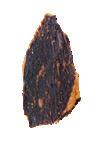


HA R VEY MUDD COLLEGE MAGAZINE 28
Vinyl Stickers | $4

Winnie Ding ’12 started Pocketful of Sprockets as a reminder to herself to embrace the fun and joy within the everyday struggles of being a mechanical engineer in the start-up world. Stock up on vinyl stickers and pins full of nerdy puns, relatable humor, and favorite foodie treats. Use the code MUDDBUDDS for 10% off your purchase.
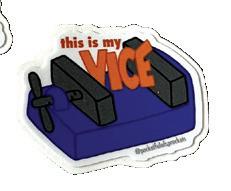

Pocketful of Sprockets | pocketfulofsprockets.square.site
Heritage Hard Cider | $15–$40

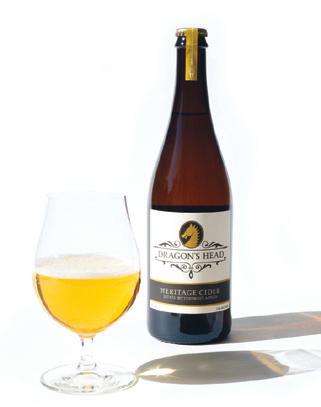
Laura and Wes Cherry ’90 moved to Vashon Island, Washington, in 2010 with the dream of planting an apple orchard and starting a cidery. Their award-winning ciders—made from mostly English and French traditional cider apple and perry pear varieties—are sold regionally and can also be shipped direct-to-consumer in 39 states. Enter ULTIMUDD2023 at checkout.
Aug. 31–Dec. 31, 2023.
Dragon’s Head Cider | dragonsheadcider.com/store
Quatrefoil Knot Necklace | starting at $60

Christopher Hanusa ’01 is a professor of mathematics and mathematical artist based in New York City. Inspired by the beauty of mathematics, he started a mathematical jewelry business where every piece is 3D-modeled using computational software and then 3D-printed in nylon or in metal through a lost wax casting process. His pieces are found in gift shops, including the National Museum of Mathematics. The featured necklace (available in brass, silver and gold or rhodium plated brass) showcases a quatrefoil knot with four lobes and an intricate crossing pattern in the center.
Hanusa Design | hanusadesign.com/products
If you’d like to suggest other alum business owners for a future gift guide, let us know at communications@hmc.edu.
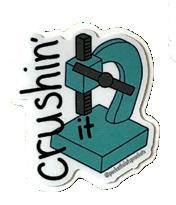
SUMMER 2023 29
MUDDERINGS
Award Season
Outstanding Alumni Awards

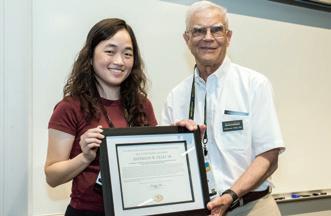

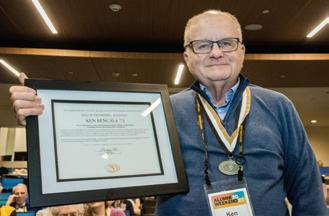

For those who exemplify the mission of Harvey Mudd and who have made a sustained and effective commitment to improving society.
1.Sharon Alderman ’63 (chemistry), one of Utah’s 100 Most-Honored Artists, is an award-winning, expert weaver. Her work has been shown in competitions and exhibitions across North America, and she’s been featured in the National Museum of Women’s Art in Washington, D.C. She has woven technically challenging prototypes for engineering firms and says that they are among the most interesting work that she does.

2. Allison Barto ’98 (physics) is a director at Ball Aerospace, specializing in developing complex space systems from vision to orbit. Among her 25 years of supporting missions for NASA and defense customers, Barto has spent over 15 years in technical and leadership roles for the Webb Telescope. She has studied future large-telescope architectures and is an International Society for Optics and Photonics fellow and board member, and she received the 2014 Women in Aerospace Achievement Award.
3. Ken Bencala ’73 (engineering) has brought dynamic modeling to the analysis of rigorous process-based experimentation in the natural environment and has furthered the understanding of the role of streambeds in determining stream water chemistry. A Fellow of the American Geophysical Union, he is the co-author of numerous articles, book chapters and U.S. Geological Survey agency reports, and his work appears in the International Association of Hydrological Sciences series “Benchmark Papers in Hydrology.” Bencala has mentored PhD students and served as co-editor of the authoritative hydrologic sciences journal Water Resources Research
4. Peter Paterno ’72 (math) is a partner at King, Holmes, Paterno & Soriano LLP and has nurtured the careers of dozens of multiplatinum recording
artists. His clients include Dr. Dre, Metallica, Van Morrison, Alice In Chains, Linda Ronstadt and Alanis Morissette. In 1990, Paterno was the first president of Hollywood Records and helped start the company, reporting directly to then-CEO Michael Eisner. Due to his extensive experience in copyright and trademark law, tax planning in the entertainment industry, litigation management and live theater production, Paterno has been involved in the formation, purchase and sale of numerous entertainment companies. He recently received the 2023 Entertainment Law Initiative Service Award for advancing and supporting the music community.
5. Jefferson Tilley ’68 (chemistry), president of TChem Consulting, discovered Dorzagliatin, a first-in-class drug for the treatment of diabetes and Resmetirom, another first-in-class drug for the treatment of fatty liver disease, which is currently in late-stage clinical trials in the U.S. Tilley served several years as an adjunct professor of chemistry at Fairley Dickenson University, where he developed and taught a course on medicinal chemistry. He is a fellow of the American Chemical Society, recipient of the North Jersey ACS Lifetime Achievement Award and has around 60 patents and 80 publications.
6. Fred Streitz ’83 (physics), a fellow of the American Physical Society, serves as the deputy associate director for outreach and initiatives in the computing directorate at Lawrence Livermore National Laboratory. He previously helped create the artificial intelligence office in the Department of Energy as a department liaison to the data element of the COVID-19 Task Force and as a senior advisor in the Centers for Disease Control and Prevention in the Center for Forecasting and Outbreak Analytics. Streitz is a two-time recipient of both the Institute of Electrical and Electronics Engineers’ Gordon Bell Prize for outstanding achievement in high-performance computing and a special recognition award from the secretary of energy.
HA R VEY MUDD COLLEGE MAGAZINE 30
The Alumni Association recognizes those who have had an impact on HMC and well beyond.
1 3 4 5 6
2
Jerome Jackson ’76 and Allison Barto ’98
Sharon Alderman ’63
Ken Bencala ’73
Joe Sinopoli ’17 and Peter Paterno ’72
Eun Bin Go ’15 and Jefferson Tilley ’68
David Sonner ’80 and Fred Streitz ’83
Honorary Alumni & Lifetime Recognition Award Honorary Alumni are longstanding friends of HMC, its students and alumni, and have contributed significantly to the College’s betterment.
7. Howard Deshong III’89 (physics), P22 is a managing partner and founding member of Galileo Partners in Los Angeles. In addition to serving on the HMC board of trustees, he serves on the boards of The Annenberg Foundation Trust at Sunnylands, the Annenberg School for Communication Trust at USC and private technology companies OWL ESG, Inc. and Heron Skill Systems. He has worked at the RAND Corporation on defense-related issues and at a nonpartisan Congressional agency. He joined Oppenheimer Investment Advisers in 2001, then founded Bristlecone Value Partners (2004) and Galileo Partners (2007).
8. During her more than 35 years at Harvey Mudd, Kerry Karukstis has been chemistry department chair, chair of the faculty and faculty representative to the board of trustees. She has mentored many undergraduate research students, many of whom have earned advanced degrees. She received the American Chemical Society Award for Research at an Undergraduate Institution for her participation as an undergraduate research mentor and her engagement in the undergraduate research enterprise through her involvement with the Council on Undergraduate Research; she’s assisted over 200 U.S. institutions in the process of institutionalizing undergraduate research. In 2003, Karukstis received the College’s Henry T. Mudd Prize, and, this year, received its Lifetime Recognition Award, which honors longtime, outstanding dedication to the College.
9. Maria Klawe received the Lifetime Recognition Award and was named president emerita and trustee emerita for her 17 years of exemplary service as president of Harvey Mudd College.
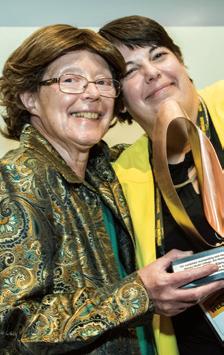
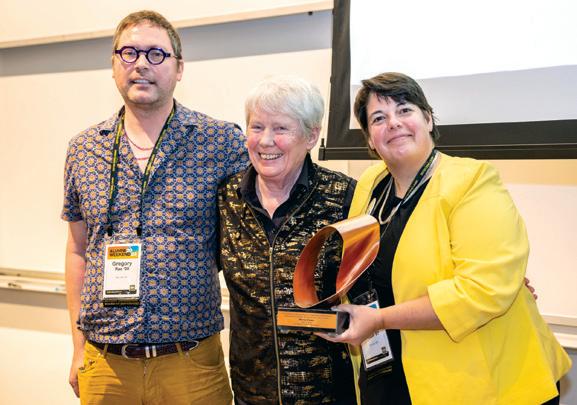
AABOG Spotlight Recognition Award
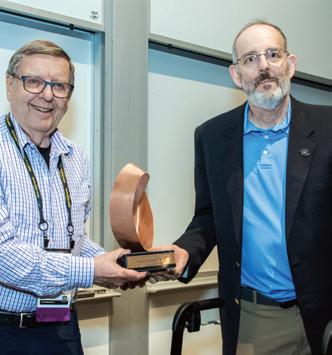
Joshua Greene ’02 (math) is recognized for his mathematical writing and its impact and value to experts, non-experts and researchers. Greene received the 2023 Levi L. Conant Prize for his article “Heegaard Floer homology,” published in the Notices of the American Mathematical Society (68 [2021], No. 1). The award recognizes the best expository paper published in either Notices or the Bulletin of the AMS in the preceding five years. His article is a survey of the emerging field of Heegaard Floer homology, from its historical antecedents to the wide variety of results and applications of this theory.

SUMMER 2023 31 MUDDERINGS
9 7
The HMC Alumni Association selects inspirational alumni whose contributions embody the College’s visionary themes of innovation, leadership and impact through global influence and contributions to society.
8
Kerry Karukstis and Kathy French ’97
Bruce Worster ’64 and Howard Deshong III ’89, P22
Gregory Rae ’00, President Emerita Maria Klawe and Kathy French ’97
Kudos to Volunteers
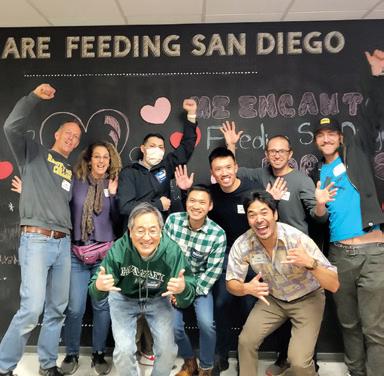
On behalf of the Office of Alumni and Parent Relations and the HMC Alumni Association, we extend our deepest appreciation to this year’s alumni volunteers. Thank you for the time and effort you have generously devoted to hosting in-person events, serving as speakers for our Mudd Talks series, and embracing various other volunteer opportunities. Your contributions have made, and will continue to make, a profound impact on the entire HMC community. We look forward to your continued involvement. If you’re interested in volunteering, please email alumni@hmc.edu.
A special shoutout to our GOLD (Graduates of the Last Decade) alumni volunteers. Your participation as ambassadors and hosts for GOLDen Connections events was exceptional this year. We are tremendously grateful for your enthusiasm and partnership.



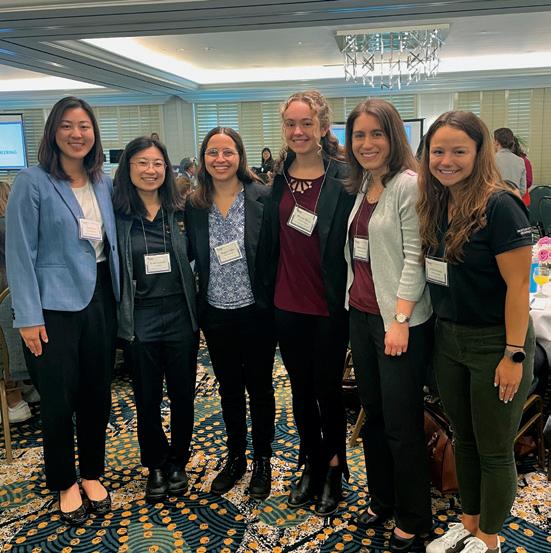

HA R VEY MUDD COLLEGE MAGAZINE 32 MUDDERINGS
Alumni and faculty members celebrate the 80th birthday of Don Remer (fourth from right), professor of engineering economics emeritus, at his Claremont home in February.
In April, five alumni Diana Lin ’22, Kayla Yamada ’19, Maggie Gelber ’19, Rebecca Glick ’11 and Andrea Zavala ’21 met a current student, Mikayla Mann ’25 (third from right), who was accepting a scholarship award at the Society of Women Engineers-Los Angeles Professional Development Conference in Torrance, California.
Volunteering with Feeding San Diego plus Happy Hour
Lunch in Sunnyvale
Paint and Unwine in Redondo Beach
Happy Hour at Claremont Craft Ales
CLASS NOTES
1967
James (Buzz) Wisda (engineering) left HMC in 1967, graduated from USC in 1969 and received an MBA in 1970. “I worked for Pardee Homes for 37 years, retiring in 2009 as senior vice-president. We built over 60,000 homes plus all the other facilities needed to complete communities. Valorie and I married in 1971, and we celebrated 51 years of marriage this June. We moved to Scottsdale, Arizona, in 2011. We built a second home in Poipu, Kauai, in 1998, and a summer home in Sugar Mountain, North Carolina, last year. We spend about six months in Arizona, two months in Poipu, and four months in Sugar Mountain. I play golf five days a week and compete in USGA and other national amateur golf tournaments. We travel often, visiting Kenya and Tanzania last year. In 2019, we spent almost two months In Scotland and Ireland playing golf. We spent a month in Scandinavia searching for Valorie’s ancestors. Pretty good considering my HMC advisor Dr. Alford wrote a letter to USC telling them not to admit me.”

1970
David Chandler (physics) taught physics and math at the high school and junior college levels from 1972 to retirement in 2012. During that time, he spent several years working at a charter school that supports homeschoolers. Seeing a need for higher quality homeschool math curriculum, David started recording the entire high school math curriculum to support the strongest standard textbooks. “I now have Algebra 1 through Calculus and last year added physics. You can see my work at mathwithoutborders.com. Through these courses, I have taught far more students in my retirement than in my conventional career.”
1972
Michael Smithson (math) writes, “I’ve been emeritus for a year now but during that time I’ve added to the collection of probability distributions with support on the unit interval. Unlike most distributions in this collection, mine always have finite densities at 0 and at 1-i.e., their support is [0,1] rather than just (0,1), so they potentially are a solution to a longstanding statistics problem. I’ve spent the last six months coding them in a couple of statistical
computing environments and crash-testing them on simulated and real data. I’m now putting the finishing touches on a paper to be submitted to the tender mercies of peer review. Fingers crossed!”
1973
The publishing industry’s largest trade association, the Independent Book Publishers Association, named Steve Hinch’s book, The Slickrock Desert: Journeys of Discovery in an Endangered American Wilderness, a Benjamin Franklin Award finalist as one of the best books of 2022 in the category of regional nonfiction. In May, Steve (engineering) received a silver award at the association’s gala dinner event in San Diego.

1974
Frank Valdes (physics/math) is an observatory scientist with NSF’s National Optical/Infrared Research Lab that operates NSF’s ground-based observatories and data center. He received international recognition for his astronomy science software, which has been used by thousands of astronomers over the last 30 years. Frank is involved in many projects, including surveys that have mapped most of the sky, surveys looking at the distant universe using the Lyman-alpha line, and running a serendipitous asteroid detection program. “I am turning 70 with 40 years at NOIRLab and plan to continue working.”
1975
Carl Carrera ’75/76 (engineering) says, “I’m just enjoying retirement and our four grandkids. We are all healthy, happy and doing well.”
Bernie Santarsiero (chemistry) reports that it’s been a busy year.
“In January, I gave an invited presentation on diversity programming for underrepresented minority (URM) students at the National
Institutes of Health in Bethesda in their Trainees Recognizing Excellence and Diversity in Science Seminar Series. The series recognizes outstanding accomplishments in both scientific research and in promoting diversity, equity and inclusion in science. In March, I gave a keynote address at the annual Illinois Louis Stokes Alliances for Minority Participation conference. In May, I was invited by the U.S. Secretary of Education to present at the Raise the B.A.R. summit at the Department of Education headquarters in Washington D.C. The photo shows me with the Assistant Secretary of Education for Postsecondary Education Nasser Paydar. In June, I spoke at the NSF headquarters in DC and at the summer meeting of the APLU Council on Diversity, Equity, and Inclusion in Albuquerque. I’ve been involved in developing institutional programming for URM students in STEM and biomedical research for the past decade at UIC.”
1977
Jacqueline Paver (engineering) is president of the 501(c3) nonprofit Center for Injury Research in Santa Barbara, California. Jacquelineearned her M.S. and PhD degrees from the Duke University Biomedical Engineering Department. She subsequently worked as a biomechanical engineer at Failure Analysis Associates in Menlo Park, at Biodynamics Engineering Inc. in Pacific Palisades and then as a sole proprietor. She performed biomechanical engineering analyses and testified for the defense in low-speed MVC fraud cases, for the plaintiff and defense in vehicle, helmet, fall and diving neck personal injury cases as well as for the plaintiff in vehicle, occupant restraint and helmet defects cases. Her research has focused primarily on head, neck and spine injury based in part on her cadaveric testing at Duke and occupant protection and anthropomorphic dummy development testing, and modeling. She is working with the USAF on manikin development and testing for the protection of aircrew with emphasis on small and pregnant females.
1978
James Logue (physics) writes, “After 15 years working on diffractive optics research and various space telescopes, followed by 20 years working in information security in Danbury,
SUMMER 2023 33
Quantum Possibilities
Award-winning, early career physicist pursues pioneering research
Written by Jen A. Miller
Photo by Anita Nowacka
anna soper’s love of math and howthe world works began in elementary school. Starting in fourth grade, she participated in math club. In middle school, she was captivated by Neil deGrasse Tyson’s Cosmos: A Spacetime Odyssey. “I was struck by how you can use elegant mathematical equations to explain the laws of nature.” She continued to pursue her interests, taking physics and engineering classes and joining related clubs during college.
Now she’s a first-year graduate student at Stanford University and a standout in the physics field. In 2023, she was one of 15 recipients of the prestigious Hertz Fellowship, awarded annually to the nation’s most promising graduate students in science and technology. “It’s a great opportunity to expand my network, learn from other researchers in a broad range of disciplines and enrich my graduate experience,” Soper ’22 says.
At Stanford, she’s working toward a PhD in experimental atomic, molecular and optical (AMO) physics. Working in the lab of Jonathan Simon, associate professor of physics and applied physics at Stanford University, Soper is designing a system of unconventional optical cavities that will allow researchers to more easily read out the quantum state of an atom through efficient photon collection. Such a system would enable the pursuit of new regimes in quantum networking, active quantum error correction and quantum simulation.
Quantum simulators “are useful for helping us understand how quantum gravity works in black holes or how high-temperature superconductors work,” she says. “The idea is that if you can build and control a quantum system from the ground up, then you can understand a lot of new physics that we haven’t been able to uncover using other experimental and computational methods.”
The Hertz Fellowship is just one of several recognitions Soper has received for her work. While the COVID-19 pandemic hampered her opportunities to do in-person research, she was still able to gain valuable experience. In 2021, while still at Harvey Mudd, she received a Barry M. Goldwater Scholarship for research in computational materials science that she performed with Professor Lori Bassman (engineering). The following year, she was a WAVE fellow at Caltech, where she did research in topological photonics and optical computing. In addition to the Hertz Fellowship, she was a 2023 recipient of the National Defense Science and Engineering Graduate Fellowship and one of seven alumni to receive a National Science Foundation Graduate Research Fellowship, which recognizes outstanding researchers who have the potential to become experts who can contribute significantly to research, education and innovation in the STEM fields.
While Soper’s path to physics seems clear now, when choosing a college she was unsure which area she would pursue—physics or engineering. Harvey Mudd allowed her to explore both.
“I wanted a smaller liberal arts college, but I also wanted to keep engineering as an option. It turns out that is really difficult to find at most liberal arts colleges.” Soper says that Harvey Mudd was the ideal choice as it has “both an outstanding engineering and physics
department and emphasizes humanities.” Despite choosing to major in mathematics and physics, she still was able to take advantage of the engineering program—managing to take most of the core engineering courses—which she says have helped her immensely with the engineering required for her graduate research.
As a violinist and violist, it was also important that college provide outlets for her to grow musically. With the Claremont Consortium, she was able to continue studying viola and participate in orchestra and chamber groups at Pomona College. Like physics, music has followed her to Stanford, where she plays in its orchestra and has gathered a chamber group of AMO physicists to play Schubert’s Trout quintet this summer.
Soper expects to earn her PhD by 2028 and then complete a postdoctoral fellowship. She hopes to continue in academia with a faculty position that will allow her to build her own research group, but she’s also open to working in industry. There’s a lot of hype around quantum computing, she says, and major technology companies, including Google, IBM and a raft of startups, all have quantum computing sectors that “hire PhD physicists in order to be at the forefront of the field.” In any case, she is excited to continue learning and sharing her knowledge with others and is grateful for the foundation Harvey Mudd provided.

HA R VEY MUDD COLLEGE MAGAZINE 34 CLASS NOTES
ALUM PROFILE
Anna Soper ’22
Connecticut, I am finally retiring. My daughter is engaged, I look forward to spending more time with my family, playing harpsichord and piano and, and perhaps, performing again.”
1979
After getting a PhD from Caltech in applied math, Michael Prendergast (math) spent 36 years in the aerospace and defense industry, retiring in 2019 to Colorado Springs, Colorado. He says, “I am married to my lovely wife, Madeleine POM ’77, and we live in a house overlooking and adjoining an 800-acre park full of wildlife. We love Colorado. My wife and I like to travel, mostly visiting places in Europe or within the United States. On one trip, we hired a guide who took us up the Dalton Highway to the northernmost part of Alaska. For fun, I develop relatively complex ’big data’ econometric models to optimize my investment portfolio and am writing a book on quantum computer programming. I also volunteer at a food bank and am a member of a county commission tasked with enabling innovation and technology within county government.”
1980
Scott Pace (physics) rejoined the faculty of the Elliott School of International Affairs in 2021 after serving as deputy assistant to the president and executive secretary of the National Space Council from 2017–2020. He’s a professor of practice in international affairs and director of the Space Policy Institute. Scott teaches graduate and undergraduate classes in space policy and consults with the U.S. government and industry on space matters.
1984
Craig Matsuno (engineering) spent the last 13+ years at ChargePoint leading the hardware group in the development of some of the first and most recognizable electric vehicle charging stations. He’s recently semi-retired but still working at ChargePoint in an advisory role and enjoying the ongoing technical challenges.
1985
In May, the University of Rochester announced the appointment of Nicole S. Sampson (chemistry) as the Robert L. and Mary L. Sproull Dean of the School of Arts and Sciences, She has an impressive background in academia and a commitment to excellence
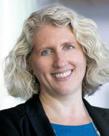

in higher education and student success. Nicole has served at Stony Brook University since 1993, where she began as an assistant professor of chemistry, then department chair and eventually associate dean and interim dean of the College of Arts and Sciences. A SUNY Distinguished Professor of Chemistry, Nicole heads a research laboratory where she focuses on the molecular intricacies of mammalian fertilization, methods for precision synthesis of polymers, and finding new treatments for tuberculosis and cholera. Since 1995, she has received approximately $19 million in research funding from multiple federal and private agencies with continuous funding from the National Institutes of Health. She has authored more than 120 peer-reviewed articles, reviews and issued patents. She co-established the NIH-funded Chemical Biology Graduate Training Program at Stony Brook University in 2009 and was the co-director until 2018. She serves on the board of directors of Brookhaven Science Associates, the entity that manages Brookhaven National Laboratory.
1987
Chris Donnelly (engineering) has been married for 20 years and has three kids. He lived in San Francisco, now in Park City, Utah, and has spent the last 15 years at Nike and Oakley as COO, head of strategy and product development. Chris says he skiis 75 days a year, mountain bikes, golfs and travels. “My priorities are around family and every day happiness.”
1990
Bryan Marten (chemistry) left NJ big pharma computer-assisted drug design about 22 years ago “in large part due to health issues. Switching to SF Bay Area public high school chem/physics teacher; enjoying the journey.” His oldest daughter is HMC Class of 2024, engineering. “Glad I was able to re-connect with Cave and let him know she was on the way for fall 2020 but so sorry to hear of his passing that semester and that my daughter never got to meet him. Youngest daughter is a high school junior looking into colleges and has lots of non-STEM interests. Great to see Daub and catch up with him via Zoom in 2021 at my class’s 31st reunion (30th was Covid-cancelled).”
1991
Eric Burke (engineering) started a new position with Alaska Airlines as manager of agile delivery. He writes, “I’m making this change after more
than 12 years with Slalom Consulting. I loved my time with Slalom and will miss so many people, but I’m also super excited for my next chapter with Alaska!”
1996
After 20 years in the pharmaceutical industry, Philip Cheung (biology) branched out and started a bioinformatics/scientific software consulting firm, Refactor BioSciences. For the last three years, the firm has been working closely with leading biotechs and Big Pharma to provide custom software solutions from machine learning algorithms for generating new compounds to building target knowledge base tools for better target selection.
1997
Joe Beda (CS) shares, “Started Google Compute Engine and Kubernetes while at Google. Left to found Heptio, an enterprise Kubernetes company that was sold to VMware. Left VMware very recently and looking forward to ‘retirement’ while I figure out what to do next and focus on my family, Rachel ’97, Anne and Nora.”
1999
During the cookie season, LaunchDarkly partnered with the Girl Scouts of Northern California to support its online shopping. LaunchDarkly, co-founded by Edith Harbaugh (economics/engineering) and John Kodumal’00 (CS), developed media assets to help GSNorCal members promote the cookie program, including providing graphic designs, Zoom backgrounds, social ads and videos that they could use to build their personal Digital Cookie online shops. LaunchDarkly and GSNorCal developed a co-branded landing page, ilovecookies.org that visitors used as a local search engine to find Girl Scouts of Northern California entrepreneurs selling cookies in-person and online. Edith, LaunchDarkly executive chair, said, “This partnership holds
SUMMER 2023 35
CLASS NOTES
ERIC MILLETTE
special meaning to me personally as I was a proud Girl Scout for many years growing up; and I learned valuable lessons about sales through selling cookies and management from being a cookie manager, while also learning the importance of perseverance and dedication to one’s goals by achieving the Silver Award.”
2000
Brett Helms (chemistry) and Michael Whittaker, preeminent research scientists at University of California’s Lawrence Berkeley National Laboratory, are leading the development of state-of-the-art direct lithium extraction (DLE) technologies for brine resources. The cooperative research and development agreement between MAX Power Mining Corp. and LBNL will allow researchers to develop new intellectual property and incorporate innovative methods and novel materials into the DLE process. Brett is committed to solving problems in energy and sustainability through the development of better materials and lower-carbon manufacturing processes. He is the co-founder of two deep tech Bay Area start-ups while Whittaker is the co-founder and director of the Lithium Resource Research and Innovation Center at Berkeley Lab. Brett’s research program at Berkeley Lab is devoted to materials discovery and development to solve outstanding challenges in energy and sustainability, including membranes for efficient ion separations relevant to resource extraction, refining and circularity. He is co-founder of two deep tech Bay Area start-ups, Sepion Technologies and Cyklos Materials. At Cyklos, his award-winning innovations in PDK circularity have been featured widely in the media. Brett is a Kavli Fellow (2019) and co-inventor on more that 30 patents on performance polymers.
2005
Margot Molander (biology) and Paul Paradise ’03 (CS) took their time before having kids, but finally welcomed Bennett Paradise on Dec. 11, 2022. The family continues to live in Seattle, where Margot has worked as a scientist at Dendreon for over a decade, and Paul has worked as a production engineering manager at Meta for the past eight years.

Madineh Sedigh-Sarvestani (physics) is in the inaugural class of HHMI Freeman Hrabowski scholars, “31 exceptional early career faculty who have potential to become leaders in their research fields and to create diverse and inclusive lab environments in which everyone can thrive.” Madineh is a visual neuroscientist working to understand how our brains create experience: the neural representation of the world that is shaped by our bodies and bodily movements. Her work builds on the diversity of brains, bodies and environments that exist in nature, using state-of-the-art technologies to unlock the brain-body interactions that derive meaningful information from the environment. She believes these discoveries will lead to new theories of information processing in the brain and new therapies for neurological disorders.
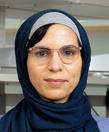
Carl Yerger (math) is in his sixth year as co-editor-in-chief of the Mathematical Association of America’s AMC 10/12 exam and is continuing to organize local activities with the Charlotte Mathematics Club. He works at Davidson College as chair of the Department of Mathematics and Computer Science. In February, he returned to Claremont to play in the CMS Men’s Tennis Ducey Cup alumni match and assisted at the World Games in Birmingham, Alabama, as president of the U.S. Korfball Federation.
2007
Badier Velji (engineering) has been promoted to director, growth strategy at Ernst & Young’s strategy consulting group. He focuses on the energy and industrials sectors and says he leverages his HMC degree every day to guide corporate clients through market and product challenges.
2008
As a research scientist who works for Vera C. Rubin Observatory, a giant telescope under construction in Chile, Meredith Rawls (physics) has been studying the impacts of satellite constellations on astronomy and our shared skies. She writes, “It’s becoming increasingly apparent that a huge increase in low-Earth-orbit satellites is fundamentally altering Earth’s orbital space environment in a way that will hinder science if we continue our current
trajectory. I recently co-authored a Nature Astronomy Perspective, titled “The case for space environmentalism,” that outlines the situation and the impacts on both professional astronomers and all Earth-based sky observers. I was also honored to be a panelist for the American Museum of Natural History’s annual Isaac Asimov Debate, on the same topic, hosted by Neil deGrasse Tyson. I am leading two student teams this summer to tackle the problem from different angles and was pleased to be matched with a current Mudder for one of them.”
2009
Aurora Pribram-Jones (chemistry), whose research focuses on quantum mechanics. and a colleague at HMC are addressing a problem that plagues much of America: lead in the pipes that carry drinking water into people’s homes. Materials scientists have been trying to find brass alloy replacements that still have all the best qualities of leaded pipes. Through the National Science Foundation’s Office of International Science and Engineering, the International Research Experiences for Students program is funding Pribram-Jones’ and Professor Lori Bassman’s proposal for three years. The two have partnered on a similar program since Pribram-Jones was in graduate school.

Terence Wong (biology) completed a PhD in biological and biomedical sciences at Harvard University in 2017 and worked for a few years in clinical diagnostics using whole genome sequencing to diagnose rare disease. In 2021, he transitioned into life science consulting at ZS Associates to deliver innovative solutions to biomedical research, clinical development and medical affairs challenges for clients in the biotech and pharma industry. During the pandemic, Terence completed an MBA with a concentration in healthcare administration at National University. In addition, he teaches a genetics course at University of California, San Diego Extension and volunteers as a mentor for the Promises2Kids Guardian Scholars Program, providing support and encouragement for former foster youth as they pursue higher education.
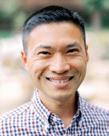
HA R VEY MUDD COLLEGE MAGAZINE 36 CLASS NOTES
2010
Sarah King (CS) wrote about “How To Successfully Manage A Team Of Software Engineers” for Forbes.com. The first task? Building trust, she says. Sarah is a software and technology leader and entrepreneur with over 14 years of experience, including five years of managing engineering teams at Netflix, Ripple and Cruise Automation. She has worked in the EdTech, FinTech, media, mobile apps, gaming, payments and autonomous vehicles spaces.
Josh Swanson (CS/math) is a postdoc at USC “writing papers; spring break in Tahiti!”
2016
Jozi McKiernan (biology) works as a data specialist for Union Station Homeless Services in Pasadena. “In my free time (among my too many hobbies), I’ve enjoyed tormenting my remote trivia group with biology-themed rounds and playing Writing Center consultant for my friends’ grad school applications.”
After completing an M.S. in math at CGU, Aleina Wachtel (math) began work at Microsoft. She writes, “I have had the pleasure of working on three different teams with tons of varying types of work: I started in network infrastructure and connectivity, then moved to a technical program manager role working on the experimentation platform for Office development.“She’s now a product manager on the Microsoft Word team and gets to utilize her technical and analytical skills and customer-centric UX and design skills. For fun, she’s been powerlifting, working out with a personal trainer and taking virtual film classes with Seattle International Film Festival. “You can catch me in the Greater Seattle area continuing to make music, collecting boardgames and buying books at a faster rate than I can read them.”
Shanel Wu (physics) writes: “Double doctorates! Shanel (S) Wu and Miranda Thompson both successfully defended their dissertations on April 7, 2023 at the University of Colorado Boulder. While both of them graduated from Mudd in physics, the two have taken different paths as researchers. Miranda obtained her PhD from the Department of Physics, where she conducted research at NIST on the current-phase
relationship of Josephson junctions with insulating and metallic barriers. She will be continuing at NIST as a postdoc with an NRC fellowship. On the other hand, Shanel switched fields to pursue interdisciplinary research in Creative Technology Design at CU’s ATLAS Institute. Their research explores the intersection of textiles, electronics, and craft to design wearable technologies. They will also be starting a postdoc, but in humancomputer interaction at Carleton University in Ottawa, Canada. Two roads diverged in the dark forest of post-undergrad life, yet remain close travelling companions.”
2018
Wenkai Qin (engineering) left his job as a GNC engineer at Raytheon and enrolled in the Aerospace Department at UT Austin as a first-year PhD with a focus on controls and doing research under Professor Todd Humphreys.
2019
Guy Geva (physics) has been teaching English through the JET Programme in the coastal town of Tomamae in Hokkaido, Japan. He writes, “I have enjoyed working with students of all levels, from first graders in elementary school to high school seniors, while learning how to be a more effective teacher. I have also used this time to improve my Japanese language abilities and received the Japanese Language Proficiency Test N2 certification last year. In July 2022, I finished my term on the JET Programme and returned to America for graduate school at the University of Southern California where I’ll pursue an M.S. in quantum information science. It has been my goal to study quantum information further since taking Professor Theresa Lynn’s class in the subject while at Mudd, so I am excited to return home to California and continue my education in the field!”
2021
Max Chao-Haft (math) has been on a gap year, applying to graduate school and doing some tutoring. He did some research with CMC Prof. Sam Nelson on braid invariants and braid group representations and plans to attend math grad school.
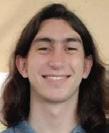
Dana Clark Boykin ’77 died in December after a sudden decline in his health.
Born in California, he lived in Altadena, South Laguna, Beverly Hills and Coral Gables, Florida, before moving to West Texas, where he attended middle school and high school. He attended Harvey Mudd then went on to receive a bachelor of arts degree in music from Austin College in Sherman, Texas. An employee of the Texas Health and Human Services Commission, he worked in systems support for the Long Term Care Regulation unit. Read his full obituary here: statesman.com/obituaries/ paco0447647.

Alan Luebs ’76 (engineering), died June 8, 2023, after a brief illness in Atlanta, Georgia. Alan earned his M.S. in mechanical engineering from Stanford University in 1977. He enjoyed a rewarding career, primarily in aeronautical engineering, that included obtaining a patent for “starting and controlling the speed of a two-spool gas turbine engine.” His keen mind and passion for living to the fullest led him to enjoy flying, sailing and model railroading, playing the piano and pickleball, and nature photography and horticulture, among his many interests. Alan is survived by his wife Juliet, three siblings, and many nieces and nephews, as well as his canine companion, Maggie.

SUMMER 2023 37
In Memoriam
CLASS NOTES
Alumni Weekend 2023
Dave Gore, Bill Frost, Nick Kerber, Mike Hughes, Dean Johnson,
Vince Jue, John Mallinckrodt, Mark McKinstry, Bob McOwen, Ellen Moe, John Moe, Gene Nelson, Chuck Knight, Joe Atkinson, Fred Bauman, Thorstein Oskarsson. Row 4: Bob Peak, Wayne Raymond, Bill Sherzer, Craig Von Bargen, Paul Yin, Larry Yujiri.

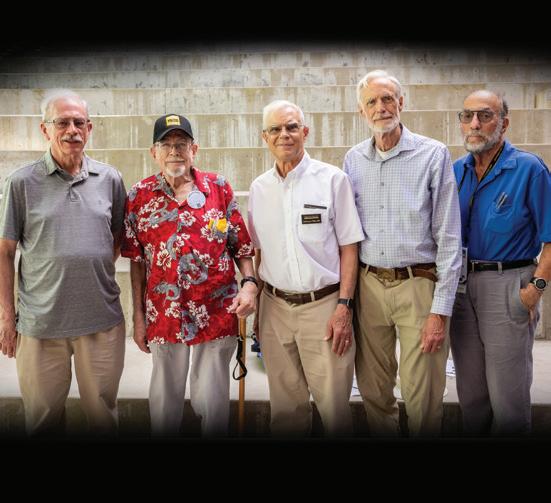


HA R VEY MUDD COLLEGE MAGAZINE 38
1963 Front: George Diehr, Dick Hoch, John Graves, Fred Tomblin. Back: Michael Blasgen, Sharon Alderman, Harald Weiss, Paula Diehr, Michael Wilson.
1973 Row 1: Harvey Lesser, Mark Allen, Ken Bencala, Steven Brosnan, Mike Bugg, Rick Cline, Buzz Curtis, Wayne Drinkward, Wilson Hom, Dan Erickson. Row 2: John Halas, Steve Hinch,
Bill Lang. Row 3:
1968 Gary Fick, Michael Malcolm, Jeff Tilley, Tom Norris, Jay Labinger
1978 Kirk Cassidy, Kat Reader, Paul Kenney
REUNION CLASS PHOTOS


SUMMER 2023 39
1982 Front: Clayton Chinn, Doug Arent, Cheryl Butler, Louisa Mak, Leticia Kurashige, John Shockley, Lance Schaina, Laurence Schaina. Back: Grace Dash, Mark Eisenhardt, Mark Rauscher, Mala Arthur, James Duhaime, George Bell, Andy Pineda.
1983 Front: Gif Cheung, Wendy Streitz, Martha Vance, Linda Miller, Grace Nakayama, Suzanne Schafer, Emily Greene, Wendy Magras, Sharon Lunt, Dave Overoye, Phil Wolf, Mike Sanchez, Frank Hu, David Gardner ’84. Back: Ross Watkins, Lance Clifner, Fred Streitz, Allen Nelson, Mark Gondek, Peter Midford, Willie Konya, Joe Anderberg, Marc Simmel, Bill Krause, Mike Sailor, Peter Wolff, Mike Magras, Dave Dunaetz.
REUNION CLASS PHOTOS
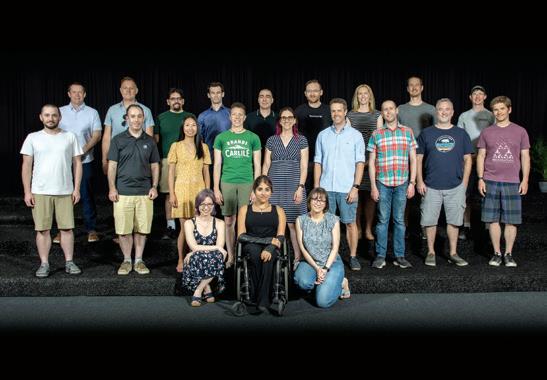



Alumni Weekend 2023
HA R VEY MUDD COLLEGE MAGAZINE 40
1988 Front: Brad Bohnert, Marilyn Hanesworth, Julia Goldstein, Karin Kent, Darlene Elsner, Steve Roth, Ira Feldman, Lou Rossi. Back:Tom Diffely, Jud Cohan, Eric Joham, Kevin Quick, Doug Franke, Marc Sugiyama, Lawrence Chai.
1998 Front: Katie Chin, Henry Chin, Nandan Das, Allison Barto, John Hartono, Burke Adams, Ben Ver Steeg, Carrie Sundra, Danielle Michaels, Bibianna Cha, Dawn Strahler, Sharon Ungersma, Kari Tani, Jill Delsman, Jen Teruya, John Larkin. Back: Andrew Hutchings, Michael Wood-Vasey, Brian Fudge, Justin Barnes, Thaddeus Ladd, Justin Busch, Jim Campbell, Zach Benz, Matt Dharm, Steuard Jensen, Ben Elgin, Phil Hilmes, Mark Delsman, Mats Cooper, Geoff Finger.
2003 Row 1: Emily Cukier, Avani Gadani, Molly Waring. Row 2: Joseph Friesen, Paul Paradise, Gigi Koe, Elizabeth Reynolds, Nicole Moore, Chip Bradford, Nick Hertl, Noah Beck, Joseph Baker-Malone. Row 3: Jonathan Grant, Ross Richardson, David Clarke, Adam Lutchansky, Will Berriel, Benjamin FrantzDale, Kristal Pollack, Trevor Oliver, Stephen Friedman.
1993 Front: Ellen Heian, Michelle Mann, Julio Loza. Back: Jon Roberts, Luke Chen, Robert Dickey, John Kerenyi.
Howard Chen, Tony Weerasinghe, Alex Lynch.
Taylor McAdam, Guillermo Esparza, Milo Toor, Tyler Ochiai, Steven Hang, Michael Loy, Monica Hwang, Karen Beaty, Max Kukartsev, Dustin Zubke. Row 2: Laura Maguire, Kacyn Fujii, Julio Elinson, El Schofield, Katarina Hoeger, Jackie Olmos-Lym, Michelle DeRienzo, Jeehyun Kim, Jeff Hemphill, Crystal Bong, Ashley Kretsch, Tiffany Liu, Nash Witkin, Max Zhvanetsky, Lawrence Thibodeaux, Olivia Beckwith, Kim Kilday and spouse, Zach Gaslowitz. Row 3: Will Villagomez, Scott Rayermann, Max Korbel, Xanda Schofield, Megan Wheeler, Tracey Luke, Bethany Okada, Hannah Kastein, Thomas Carey, Kenny Buyco, Brianna Posadas, Julie Zhang, Rebecca Streitz, J Brill, Braden Neufeld, Jessica Stringham, Ada Avery. Row 4: Andrew Hilger, Cory Evans-Klock, Rai Feren, Brett Burley, Alejandro Frias, Tyler Smelt, Chris Gage, Kenny Huang, Will Ferenc, Christopher Cotner, Erik Littleton, Katie Hauser.


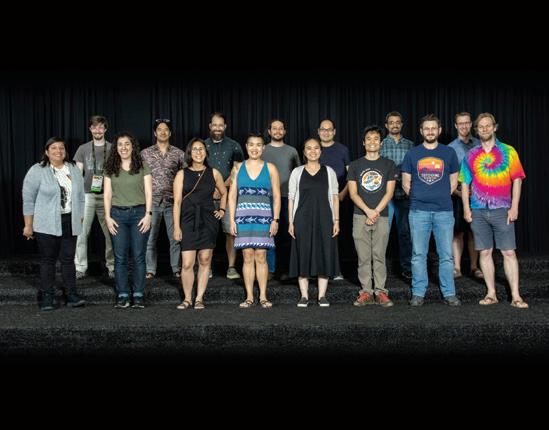
SUMMER 2023 41
2018 Row 1: Gus Callaway, Moira Dillon, Jonathan Kupfer, Isabel King, Duncan Crowley, Sarah Silcox, Amy Huang, Tiffany Fong, Marina Knittel, Sangheetha Naidu, Nancy Wei, Angela Zhao, Marissa Lee, Reiko Tojo, Kyla Scott. Row 2: Bryce Murley, Michelle Lanterman, Jacey Coniff, Arthur Reyes, Lee Norgaard, Tina Zhu, Chen Jie Xin, Zayra Lobo, Jennifer Havens, Sarah Hale, William Lloyd, Amberlee Baugus, Rachael Kretsch, Anthony Romm, Andrew Bishop. Row 3: Kamau Waller, Brian Cheng, Eli Carbonaro, Charles Van Eijk, Yashas Hegde, Sean Mahre, Doren Lan, Stetson Bost, Eyassu Shimelis, Jacob Rosalsky, Richard Ni, Christopher Kotcherha, Juliet Forman. Row 4: Christopher Hoyt, Lam Huynh, Evan Atchison, Zachary Shattler, Prat Kapur, Kevin Bengtsson, Owen Morrison, Pip DiGiacomo, Adam Shaw, Nicholas Sakowski, Alex Goldstein, Jacob Roth.
2008 Front: Rocio Ruelas, Gena Urowsky, Margaret Ho, Natt Supab, Tia Sondjaja, Chris Pong, Matt McKnett, Mike Buchanan. Back: Sean Meenehan, Kai Mayeda, David Gross, Phil Miller,
2013 Row 1: Carl Walsh, Ellery Walsh, Sarah Johnson, Grant Ukropina, Alyssa Siegman,

Nonprofit Org. U.S. Postage PAID Claremont, CA Permit No. 35 301 Platt Boulevard Claremont, CA 91711 hmc.edu/magazine
Class of 1978 alumni Kirk Cassidy, Kat Reader and Paul Kenney reunited on campus for Alumni Weekend, attended by more than 550 alumni and guests. Find more class photos beginning on page 38








 Austin Froelich and family member
Katie Johnson and Professor Xanda Schofield ’13
Sonia Bliss
Back: Mavis Stone, Ella Blake; Middle: Jeremy Bakken, Emma Lickey, Eric Corona, Helen Chaffee, Jackson Castro; Front: Inci Anali, Ruby Foxall, Sydney Cornell, Bela Quintas
Austin Froelich and family member
Katie Johnson and Professor Xanda Schofield ’13
Sonia Bliss
Back: Mavis Stone, Ella Blake; Middle: Jeremy Bakken, Emma Lickey, Eric Corona, Helen Chaffee, Jackson Castro; Front: Inci Anali, Ruby Foxall, Sydney Cornell, Bela Quintas




































































 Written by Leslie Mertz
by Dana Edmunds
Photo
Written by Leslie Mertz
by Dana Edmunds
Photo






















































